#the style of both the manga and the colors of the anime are just so good!
Text




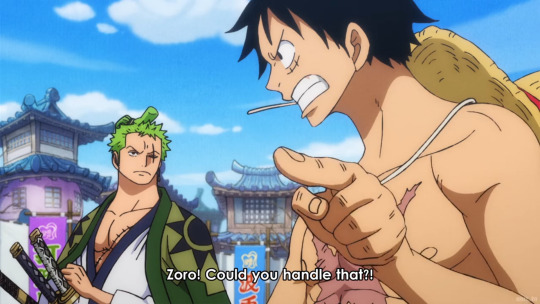
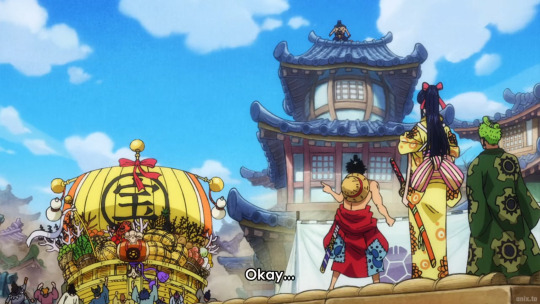


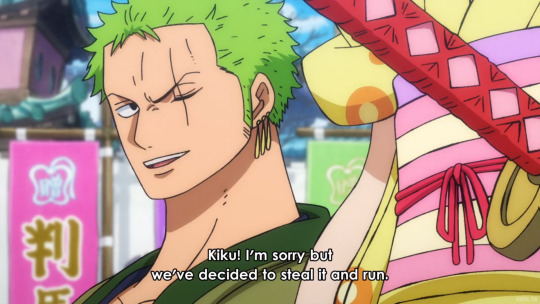

kiku getting the first row to luffy and zoro understanding each other on the same wavelength

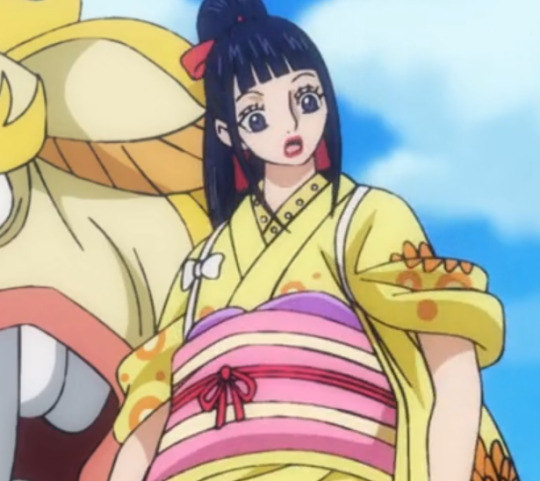
manga version:

#'we've decided' ok loll#same braincell working immediately. you love to see it#zolu#luzo#one piece#zolu wano#wano arc#one piece wano#mine#gif:op anime#gif:op manga#gif:zolu#one piece ep 905#one piece ch 917#monkey d. luffy#roronoa zoro#one piece kiku#also kiku!! i love her already! cant wait to find out whats her deal!#i found the eps in good quality.. i might make some wano gifs more often now going through this arc. maybe.. depending on work#the style of both the manga and the colors of the anime are just so good!#long post
283 notes
·
View notes
Text
Why The Dungeon Meshi Adaptation Worked So Well
The final episode of Dungeon Meshi season 1, (ep. 24) is like if you took all the best parts of the series so far, all the elements that make it what it is, arranged them all into a luscious charcuterie board, and scraped the whole thing into your mouth in one go like the hungry little bastard ye are.
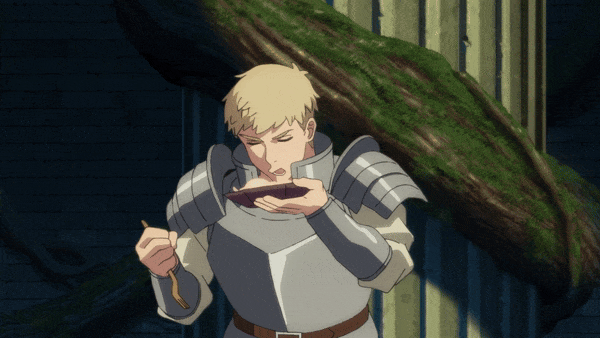
Series director Yoshihiro Miyajima has shown his dedication to the story and ability to stay true to the source material while enhancing the most important elements and making adjustments when needed to better fit the medium, and that's on full display here with the final two anime original scenes that hint toward the future of the plot and take what would have been a good but not amazing ending for the season and turn it into a great one.



As well as Nobutoshi Ogura's storyboards, whose symmetry and point-of-view and reflection shots always add a touch of foreboding and personality to what's already there in the manga.



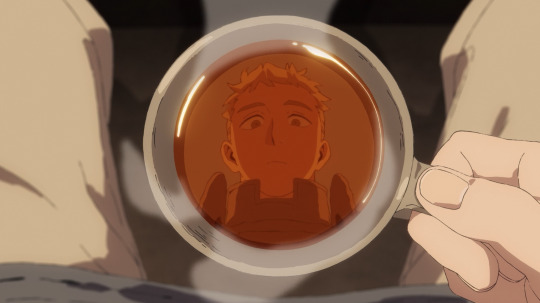
Or the addition of color to the scene in the tram where the deep green benches and warm orange glow of electric lighting gives it the comforting atmosphere of respite from the hectic action that came before it -- or a calm before the storm (?)...
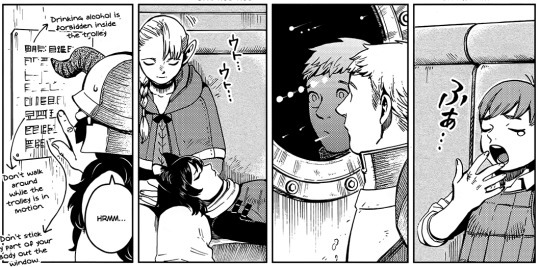

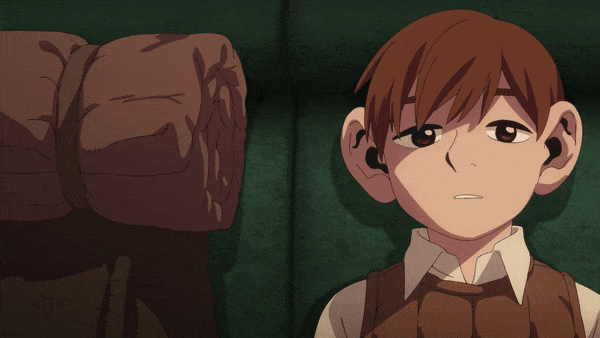
But most obvious to me in particular was they carved out a spot for many of the eccentric key animators who have defined the visual style of the show (and who I've pointed out specifically in past episodes of my breakdown series) to go nuts and do what they do best.
Ichigo Kanno's bombastic action with stylized character designs and insanely detailed wrinkles and shadows:
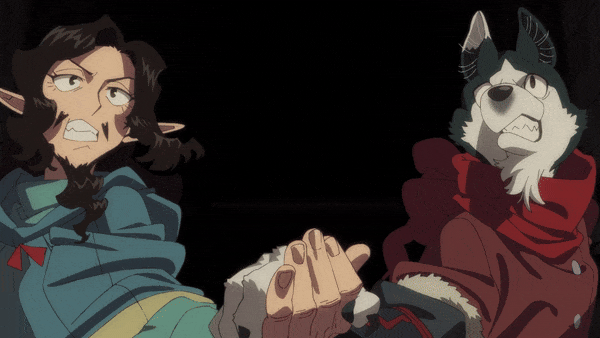

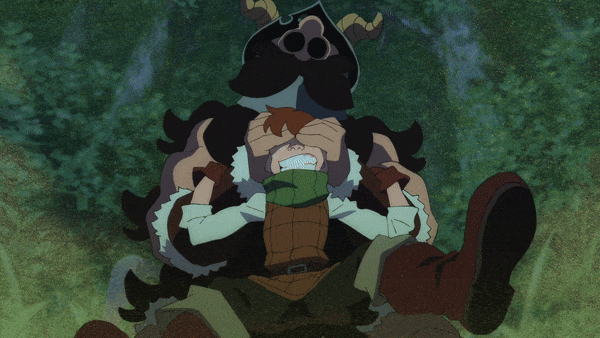
Atsushi Yoneda's clean line work and uncomfortable realism:
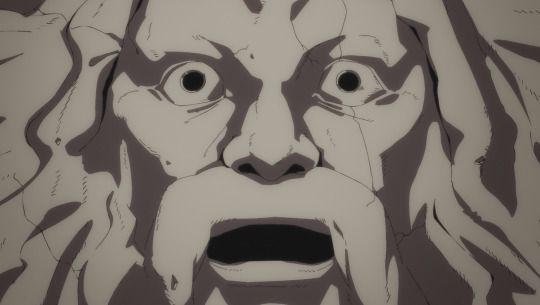


Haruki's character acting and subtlety:


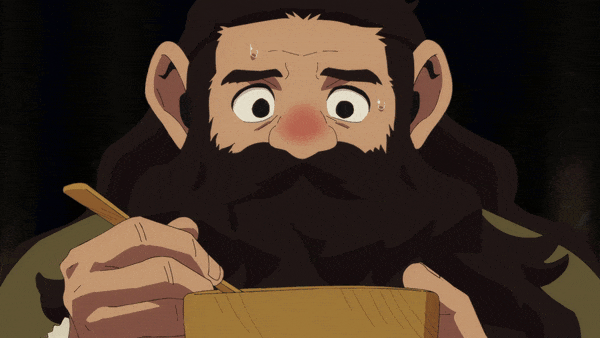
Despite the slight awkwardness of having to finish off the changeling plot in the first half, this really is a culmination of everything that's come before and a great end to the season.
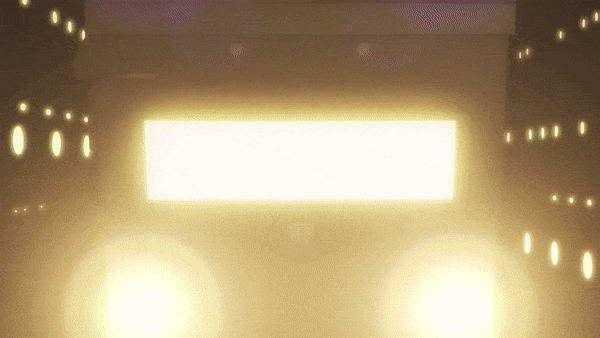
There's a whole lot more where this came from, and I get a lot more into the details of the animation in this video where I broke down the entire episode in detail, so if that's something you're interested in, check it out!
youtube
Thank you for reading, and double-dog-thank you if you've been here through this whole series -- I had just started trying to figure out how to use tumblr when I started making these breakdown posts and the response has been amazing both on here and on youtube, so thanks!
#dungeon meshi#laios touden#marcille donato#senshi#chilchuck#izutsumi#video#animation analysis#mini essay#youtube#delicious in dungeon#video essay#gif warning#anime#Youtube
3K notes
·
View notes
Text
“The Ambiguously Brown Character™”- The Attachment to Eurocentric Beauty Standards
“maybe im petty but i wish people knew how to draw like different nose shapes. Sometimes I’ll see a character I like but im like that is not what their nose would look like.” @the-eldritch-it-gay
You’ve seen them before. The one character that has brown skin… And everything else about them is… an enigma. They’re not supposed to be white! You know that much… right? You can see what the designated white characters look like, so at least it’s not that. You could claim them as Black, if you want, and sometimes creators even demand that this character is Black. Depending on the quality, you’re either like “no, what the fuck is this” or you’re like “okay they’re cool, we’ll take them”. Representation is important. But… There’s a pit in your stomach that wonders… Are they really? Are they really supposed to be Black, is this really representation, or did the creators just toss a brown person in so all the Brown™ people could “have something”, so that they would look like they cared about “diversity” on their art resume?
Examples



Theseus, in my opinion, looks like a white man with a tan. Dionysus looks a little better with the similar skin tone, due to his purple hair coloration. Apparently people do think that at least Dionysus is a man of color. What’s interesting about both of these characters, is that they’re only about two desaturated browns lighter than Patroclus, a character in the game that we’re supposed to believe is Black (whom, in my opinion, also looks like a brown bucket tool character. I’m still claiming him, he’s my guy. But his design should have been more explicitly Black). Theseus and Patroclus are the two darkest-skinned dead humans in the first game. So… what was I supposed to think about these two? Was I supposed to think they are really dark white people, due to the thin textures of their hair? Are they men of color? Are Theseus and Patroclus supposed to be ashy because they’re dead, is Dionysus ashy because he’s dehydrated from wine? Why don’t the white dead people look off color? Hades was entirely too striking a game in use of color for the browns to look like… this.


Noe and Hibana are interesting. It was complete coincidence, the purple hair and eyes thing btw. Hibana is interesting because Ogun is an unambiguously Black character in Fire Force, and there are at least three other unambiguously Black characters in Soul Eater as well. So we know the mangaka knows how to draw Black people in their style! So… was this on purpose? Is this another of those ‘tanned anime girls with titties’ meant for shounen fan service? I’ve claimed Noe (Case Study of Vanitas) because Black French people exist and France has stolen so much from us already, but it is never actually specified what Noe is. He’s just the One Singular Brown Guy in this show, with regular, untextured anime hair. Are there more brown people in the manga? Is this explained? Because we know who is supposed to be white! If anyone else wants to claim Noe, they absolutely can, because we have no idea what he’s supposed to be. Hot Chocolate thinks he’s Indian, and I’m not going to argue that because… who knows! He very well could be!
My very first lesson addressed this, albeit lightly! There’s a reason that I said that if you gained nothing else from me, that’s what I want you to walk away with. Now that I’m on stronger footing with this blog, I can really get into the nitty gritty of what that really means.
Obligatory disclaimer: we are not a monolith!* As of 2015, it has been researched that African populations have the highest genetic variation on Earth*, with a lot of that genetic diversity in sub-Saharan Africa alone. This means that YES, there very well can and will be Black people with naturally thinner textures of hair, blonde, light brown, and red hair, straight, narrow noses, monotone lips, and lighter skin that comes more often with white people. There are enough genetic combinations within African peoples and of the African diaspora that I’m sure there are plenty of people that look the way people seem to want Black people in art to look, if those genes so express within them.
*as a scientist, I will say: while these papers seem fairly legit and I looked at many related articles and their sources, take Nature with a grain of salt. Though their vetting process has become much better, you can and should always do further reading on your own!
Here’s the thing: the possibility is not the issue here!
The first issue: I don’t have to teach anyone how to draw those features on Black people! It is evident, from the professional and fan art I’ve seen, y’all already know how to draw the features deemed highly by Eurocentric beauty standards. Those features are excessively focused on and promoted as part of “good art”.
The second issue here is that the average artist drawing a poorly done Black person is not considering things like genetic diversity when they draw them (and if they are, it’s usually as an excuse post-confrontation. Yes, I have seen it.) These creators are not designing these characters with the intent of them being Black with those features, they are designing “Black” people with features that they deem most aesthetic and are most comfortable with drawing.
And why do they deem those features most aesthetic? We’ve circled back to the point of this lesson!
Eurocentric Beauty Standards
Definition: beauty standards as defined through a white, western cultural lens, including but not limited to: straight, blonde hair, light eyes, pale skin, high cheekbones, narrow noses, thinness. It’s a way that white western people want other white western people to look to be considered classically attractive… and then enforced that on everyone else.
It affects people of color worldwide. Anyone that has ever had to deal with European colonization or imperialism has to deal with the interjection of Eurocentric beauty standards.
Examples
-Black women, standing at the intersection of Blackness and womanhood, especially deal with the constant pressure of Eurocentric beauty standards, being consistently told to hate ourselves due to our own ethnic features. It’s incredibly damaging to your self-esteem growing up; my mom told me that until I went natural at 17, I was determined to look ‘like a white girl’ because I thought it would make me beautiful, and it hurt her. And as for me, it was a stunning realization that at 17 that I had never really seen my own natural curl pattern before. My hair was in ponytails and such as a child, but as a teenager, growing into my identity, I had always wanted straight hair. I was in love with my coily texture, I couldn’t believe that I’d never seen it. An entire part of my own body, gone unknown, because I wanted to fit a beauty standard I would never reach.
-Kenneth and Mamie Clark: The “Doll” Studies: Black children- age 3-7 were shown white and Black doll babies, and were asked a series of ‘positive’ and ‘negative’ identification questions. Even by that young an age, most of the Black children associated things like beauty, kindness, and positivity… with the white dolls.
-“The Golden Ratio”: a survey was done in Britain (oh boy, here we go) to determine what people felt was the ‘most beautiful’ face, and apparently it all came down to “symmetry”. “International blueprints of beauty” they claimed, were applied, as humans “naturally seek symmetry”. In 2015, according to ye olde Daily Mail, this was the most beautiful woman. You'll never guess:

(It’s not even her natural hair color!)
-Another “research study” using E-FIT (Electronic Facial Identification Technique -- a facial recognition software used to create criminal profiles based on eyewitness descriptions; no WAY that THAT could get problematic!!) to determine what 100 people thought was the “most archetypal face of beauty”.
They came up with a figure similar to Kendall Jenner as the female option.
(Guys, we’re never getting out of here at this rate.)
-We’ve spoken about discrimination against Black hair before, and how natural hairstyles will be deemed less professional or appropriate for school, regardless of the brilliant mind that sits underneath it, and even the history of Black women having to cover their hair so as to “not steal the desire of white men” and ruin the status of white women.
Appropriation:



I try to have nuance on the Kardashians, but I have never liked Kylie, and it’s not because she’s not allowed to do what she wants with her body. I watched the world claim that she was so beautiful, that her kits were why her lips looked “so good”. Everyone wanted to have “full, plump lips” like the ones Kylie BOUGHT. But Black women’s full lips have been treated horrifically since racism was invented. In 2016 I watched racists dogpile and mock Ugandan model Aamito Lagum for her naturally full lips in her MAC campaign, after saying in just 2015 that Kylie’s lips were “top fashion and everyone wants them”. And she lied (not that we didn’t all know that)! She appropriated a look, and she lied about it to move product. And people who had no right to forgive her did so, and everyone moved on to make her a billionaire. Because full lips looked good… as long as they weren’t on a Black woman. I can’t even have my own lips, but she was rewarded with an industry for appropriation. No, I’m not getting over that.
I could go on, but I won’t. So what are some ways to address the existence of Eurocentric beauty standards potentially biasing our creation?
First thing: LET’S TRASH THE IDEA THAT BROWN SKIN AUTOMATICALLY MEANS BLACK.
Black people are not stupid, and we do have expectations. Splashing brown paint on your otherwise white character does not mean I’ll automatically think they’re Black. I’m going to look. When I see brown people in real life, I can usually tell when they don’t look like me. I don’t look at a South Asian similar to or darker than my shade and say “they’re Black”. Blackness is not just skin color, it’s an entire identity and sociological construct. Yes, you can tell us apart.
Acknowledge when you’re holding a bias:
For example: “Tall, dark, and handsome.” What did you picture? You must understand that different people had different ideas of what this meant, versus who it was actually meant to be. Because on its surface, that description includes tall Black men with dark brown eyes and dark hair! We’ve talked about this in lesson 3! Whoever came up with this phrase didn’t mean skin though, they meant hair and eyes- they meant white brunettes. Even in this, it was only meant to include whiteness. And we were all supposed to assume that, be damned anything else.
Part of that is knowing what things do and don’t fall under the category. They were listed off earlier: straight and wavy hair, blonde hair, colorful eyes, thin noses, high cheekbones, double eyelid with round eyes that “show youth and innocence”. People have been going the “aquiline nose” route lately to claim more diversity in nose shape but like… even that isn’t always going to be the case. Every Black person is not going to have an aquiline nose. It is not the “middle ground” of diversity. Draw us with some round noses. We look fine.
Often ignored (in depictions of Black people): afro/coily hair and natural styles, large, round noses, full faces, brown eyes, full figures that aren’t oversexualized, body fat. One of the characters from Craig of the Creek that makes me so happy is Nicole, Craig’s mother. When I look at her design, I see my own mother. I see a Black woman that… actually looks like Black mothers I know. It made me happy and comfortable.
White folk, you even do it to yourselves! I mentioned to a friend once that a good chunk of stories in our fandom with the blonde/brunette white character dynamic read like an Aryan fantasy: the blonde character will be treated like a god on high, the most beautiful of humanity, and then you’ll get to the brunette and it’s “my meek, mousy brown hair, my dull, brown eyes like dirt, and my tanned skin with freckles; no one would ever notice someone plain, nerdy, and unimportant like me until him” lmao like excuse me? Author, you okay there pal? Do you need a hug, lmao? I can’t take it seriously anymore. If y'all are being this mean to each OTHER about not hitting Eurocentric beauty standards, y'all are certainly not being nice or respectful about people of color- who never can- in your content! (and no, exoticizing Blackness is not respectful.) You should look out for how often this happens, and catch yourself when you’re doing it.
Creating with Intent (and the lack thereof!)
(This is so important I made the header larger)
You have to actually consider and reference REAL Black people when you’re drawing Black people. That seems like such an obvious thing, and yet it must not be, because these sorts of arts/the techniques used in them still happen.
For example:


credit to my friend @devilatelier; I asked for the worst Black art ever and he heeded the call!
I abhor art like this, and art that does varying versions of this. To the pit of my soul, hatred. I will not share your work if I catch even a whiff of it. Why? Because people know that this isn’t what we look like! If you get on the computer and type in “Black man with short hair”, option A is not even remotely on the first page. You’ll get nonblack men that show up, thanks to Google’s algorithm (another conversation), but the Black men don’t look like A. If you get on the computer and type “Black man with long hair”, you’ll even get Black men with all textures and styles of hair, including straight! And they still don’t look like B. Go ahead, I’ll pause- go type it in and see what you get. Have you ever seen a Black person that looks like these images? Be honest with yourself. Why do you let them slide, if you haven’t?
Why This Matters
So it’s not about the actual Black people in their lives that they’ve seen, that makes artists draw characters like this, nor a dedication to accuracy. Because if you were looking at us at all, you wouldn’t draw this. And yet, people draw it, and post it proudly. So there must not be any shame behind it, or they at least are comfortable enough with their target audience to think it’s presentable! That begs the question- who is your target audience, and do you include Black people in it?
It’s how people like Jen Zee can have a successful career at Supergiant despite drawing dark skinned people the way she does. It’s because studios recognize when their target audiences are not perturbed by, and therefore will still buy, their product. If poorly drawn Black people does not perturb audiences enough to affect the almighty dollar- or, in fanart situations, the value of popularity- then there’s no motivation to stop doing it! Who cares about the value and the demeaning of Black fans, right?
Think about it like this. You remember how everyone bullied the Sonic studio and they scrapped their entire reel? People do not get that much up in arms in solidarity about the antiblack treatment and depiction of Black characters. It’s how you end up with Wyll Ravengard on the drop of BG3. Because Larian could have stood on business, had some integrity, and said “this is a character we are going to develop, because there will be fans that look like Wyll, and deserve to receive our best efforts at inclusion.”
But instead, Larian said “this is what our majority fanbase wants, and apparently it is not a well-developed Black character” and released that game as it was. To rousing success. That was a choice. The antiblackness of both the fans and the studio, via their lack of concern about Black gamers, was involved in making that decision. We have to let go of the idea that antiblack racism is incidental, and not a part of the process- and that includes in character design.
I cannot tell you how much it shrivels my heart inside when I see a “Black” character with wavy hair. One, because I know the artist’s first thought was not to have a Black character with wavy hair, but because they draw white people with that hair and thought it was transferrable. Two, because if you wanted the aesthetic of hair down to the back… Locs could have worked! The same shape would be there! You can style locs in any way, and it would be fine! Even if you wanted them to have thinner hair, fine, but… I can see where the intent (and the lack thereof) is. We can see when you aren’t even trying for us!
I asked Angel how he felt about creating the “white man with the brown bucket” images, curious about how he felt given that he is more than capable of drawing Black people. His response was noteworthy, and consistent with my hypothesis:
“Thinking about it, these two drawings have been the most difficult thing I’ve had to draw, period. And it’s the first time I’ve actually felt nauseous during the drawing process from start to finish. I constantly felt like I was fighting off the part of myself that knew better, telling me that this is wrong. It felt like a betrayal, knowing what Black people actually look like and still choosing to be disrespectful. Especially because I worked on the first two and immersed myself in references and also Black youtubers, researching Black hairstyles. It felt like a betrayal to all of that to call these two (deliberately poorly drawn) characters Black, because they’re not. None of the Black people I found during my research (both photo references and videos) looked like these. at all. It felt cheap, it felt lazy. Creatively lazy in the way that you just take a white person and paint-bucket them brown and call it a day. In the way it makes you feel no pull to change what you do, or learn something new. Kinda like a thought terminating cliche. Unlike the first two, I used no references for them, but I mostly based them off of actual designs I’ve seen in fandoms, both fanmade and not.”
Conclusion
So what I want us to consider for now is: if we know that’s not what Black people look like, but so many people are willing to do and/or accept it without any mental dissonance… how much do they care? Why is this allowed to ‘pass’, if we recognize that it is not accurate, unless we think what we are being presented with is acceptable? Or at least, not worth fighting over? Why not? Why do you not think that this Black character deserves to be unambiguously Black? And why does that ‘better’ way to exist always come back to whiteness?
We’re going to get into this, as well as more into the other, more overt and equally harmful manifestation of these beliefs in the next lesson on Whitewashing! But I want you to simmer on this part, first.
When you draw a character that you want to be Black, not only should you keep in mind your intent of how you’re going to draw them, but it also means putting in the work to make sure you’re doing so. You do not put pen to paper and “accidentally” draw a white man lol, it came from somewhere- let’s shatter that connection that views white features as superior, as 'ideal for attention grabbing', so we can create better. Because remember, it is the thought that counts, but the action that delivers!
#THIS IS A LONG POST- TAKE YOUR TIME#creatingblackcharacters#black characters#black character design#character design#antiblackness#eurocentric beauty standards#racism in media
2K notes
·
View notes
Text
More in depth analysis about the Spy x Family Manga Cover Chairs and Bonus Artworks (Or me just overthinking Endo’s decisions in everything and as always long post, please bear with me)
So I wanted to talk about something that I noticed about the various designer chairs that is featured on all manga covers.
Endo did say that he thought about how each chair matches the personality of the character, regarding it’s style, design or the color.
But I like to talk about something different about the chairs-it’s size or the seating capacity and how it reflects the characters relationship with others or their views about relationships. Also, I’m going to share something significant about the comedic bonus arts that also feature the chairs.
This focus mainly about Loid, Yor and Anya‘s Chair (including Fiona’s Chair) and the bonus illustrations that came with it.
Volume 1-Loid’s Chair: Le Corbusier LC2

There are two versions of this chair in the manga/anime, the love seat and the one seater. Loid is seated in the one seater chair in this cover, it means no one can sit there with him that reflects how reluctant he was in letting other people in his life. He wasn’t open for relationships (You can notice that those who are like him, intelligence assets; Franky, Fiona, Handler all sit in one seating capacity chair).

The bonus artwork was Anya sitting on the chair copying his pose. She’s the most fitting person to be in this seat because she can see through Loid’s mind, she basically knows who he really is and she likes him for that. Anya was fond of spies and she was excited about being part of his mission.
Volume 2-Anya’s Chair: Marshmallow Sofa
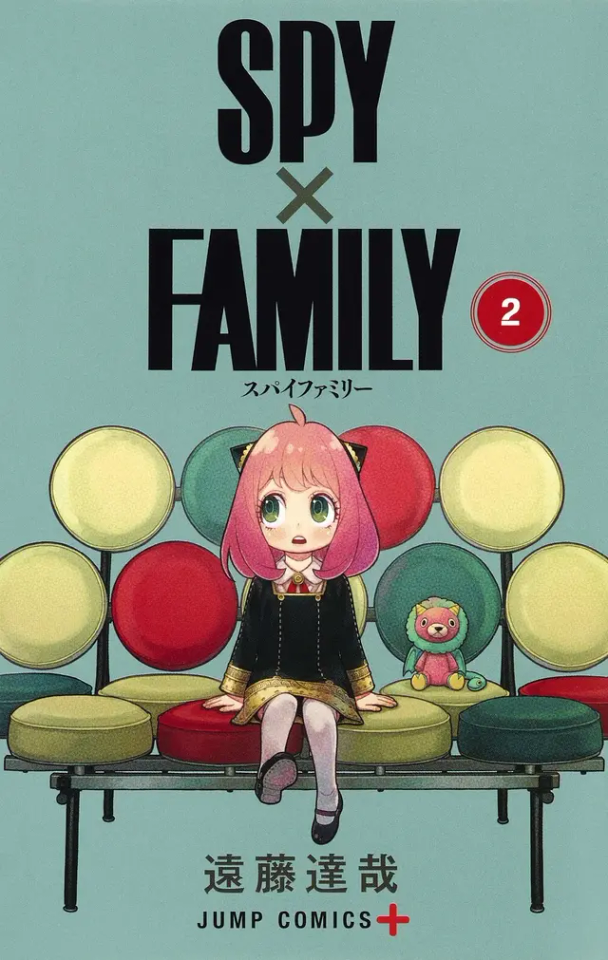
Anya’s chair has a large seating capacity and she was sitting at the middle, waiting for the empty spots on her both sides to be occupied. This depicts Anya’s anticipation for forming relationship with other people, about her wanting parents, a family, to be there for her.
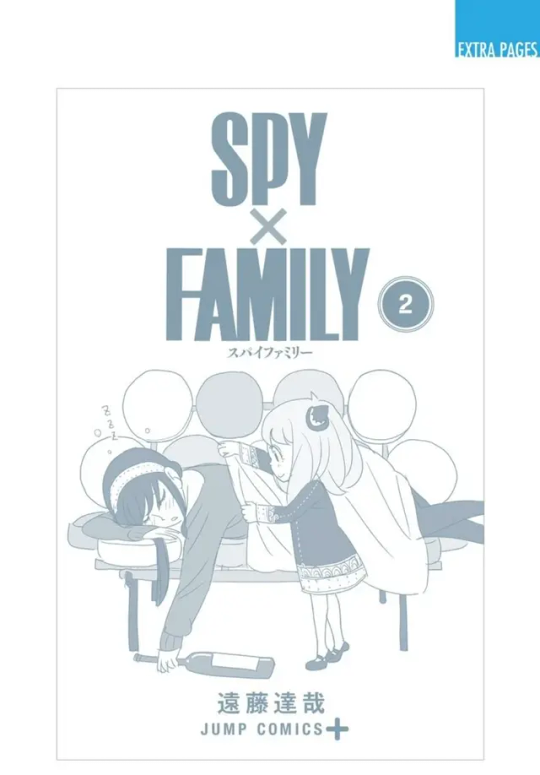
The bonus artwork was drunk Yor lying face flat on Anya’s chair. This artwork, for me, reflects Yor’s unwavering affection for Anya and Anya’s appreciation of Yor. Even drunk, she’s determined to protect her, as if she was her real daughter as seen during the castle chapter. She is fond of Anya.
Volume 3-Yor’s Chair: La Chaise (Featuring Fiona’s Heart Cone Chair)
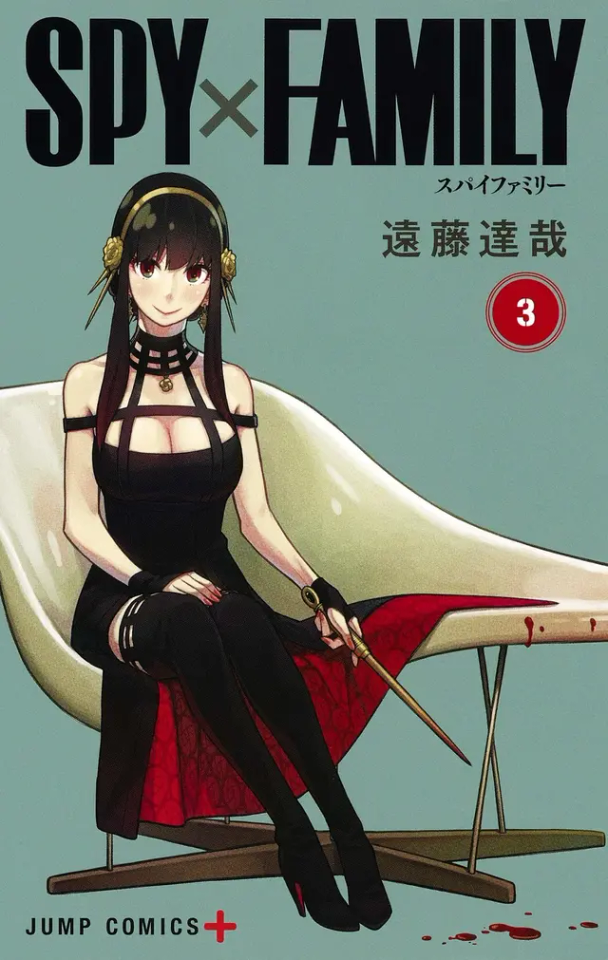
This is the chair I wanted to talk about and I have to use Fiona’s Chair for this analysis for Endo said that Fiona is designed to be Yor’s contrast and we can clearly see it in their chairs.
The seating capacity of Yor and Fiona’s chair greatly differ. Yor’s chair was big, Endo pointed how it didn’t even fit the cover, and even though Fiona’s chair is big too, she’s the only person who could sit in it. Other people can fit Yor’s chair but not with Fiona. I analyze this as Yor being open to genuine relationships and selfless while Fiona being closed off and selfish.
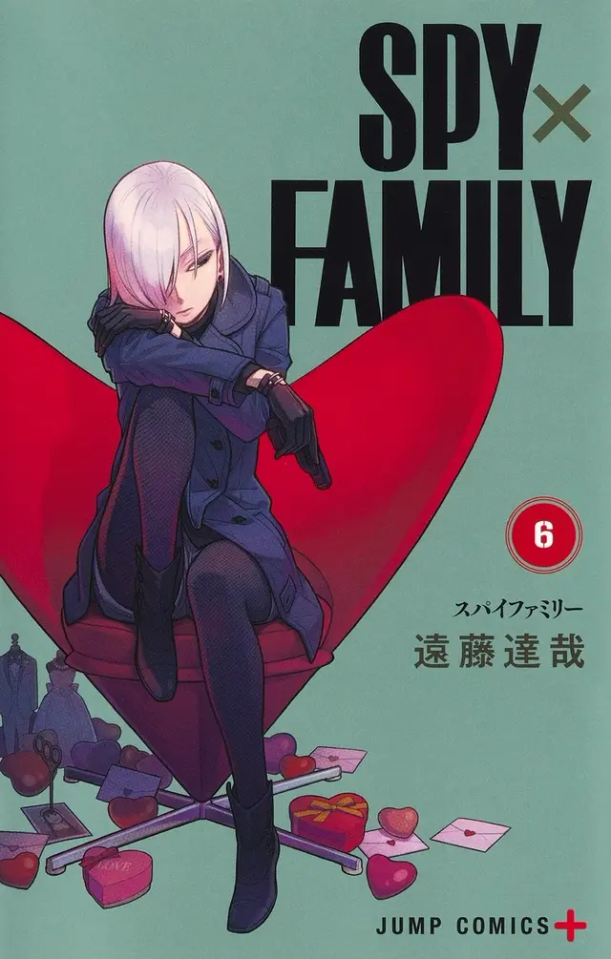
We know Yor’s motivation for being an assassin was for Yuri, for the sake of other people, and what is Fiona’s motivation? Clearly it was mainly for Twilight to marry her, love her and it was evidently show with all that stuff hiding behind her chair. I’m sure she experienced a lot of traumatic stuff that led to her being a spy but I don’t see other praise worthy and selfless motivations from her that was aside Twilight’s affection. Don’t get me wrong, she’s an interesting character and she isn't a bad person but I’m not really a fan of her personality just like I don’t like Yuri’s obsession with her sister.
In Yor however, she has nothing under or behind her chair. Just that blood that wasn’t even behind or below her chair. She wasn’t faking anything about her personality. It’s true that she accepted her marriage to preserve her assassin job but she genuinely wanted to marry Loid because he was the one who acknowledged her selflessness and that was enough for her to completely entrust her life to him. She welcomed Loid and Anya to her life because her longing for a companion to share her life with is as big as the size of her chair.
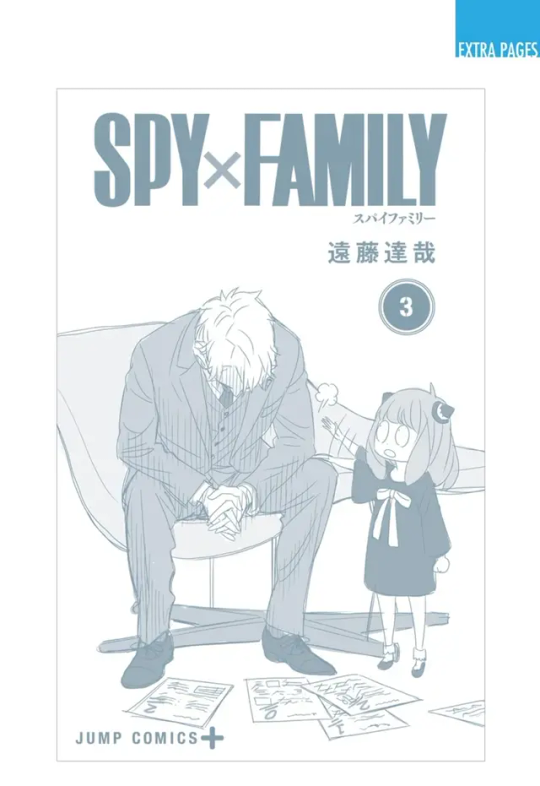
The bonus art in Volume 3 was Loid sitting on her chair. Despite the comedic set up of these illustrations, I think the people who tend to sit on the chair on the bonus arts were the ones who gets the person on the cover the most.
That is why Anya is in Loid’s (Because she can read his mind) Why Yor is in Anya's (Because Yor lost her parents at a young age too and she knows how to care for Anya because she did that to Yuri) and why Loid is in Yor’s chair (Because Loid understood her self sacrifice because he too, is the same as her) Also why Anya and Bond are in the bonus of Volume 4 because the two of them get each other, being both experimented on.
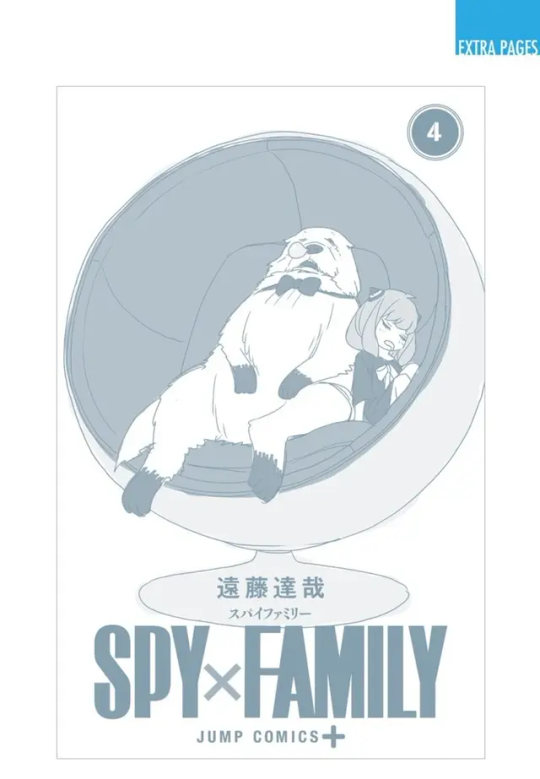
I also have some analysis about Volume 5-12 and the bonus artworks as well, but I might post them in another time since I haven't seen the translated bonus artworks in Becky and Emile and Ewen's Volumes.
But let me know if this analysis makes sense to you.
#spy x family#spy x family manga#anya forger#loid forger#yor forger#twilight#twiyor#spy x family anime#sxf anime#sxf manga#sxf thoughts#sxf analysis#The chairs are really playing significant roles in their character#Endo must've spent a lot of time thinking about it#Everything about the chairs just fits them#I'm excited to see who's going to be on Volume 13's cover#But my hunch would be either Henderson or we will repeat a character
538 notes
·
View notes
Text
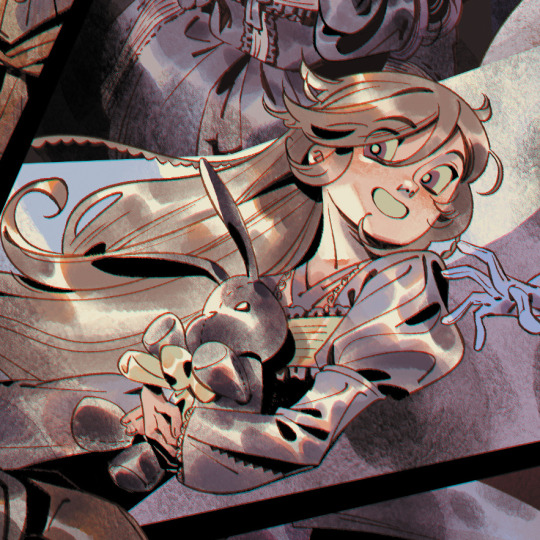
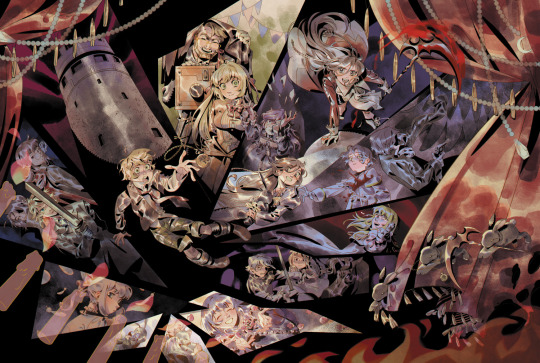
"Lament! Terror! Despair! I shall kindly teach them all to you! And in your final moment, I... shall kill you by my own hand!!"
pandora hearts print for anime north this weekend 🥀🖤🤍
I also put this up on my inprnt! there's a sitewide sale for 40% off right now 🌟
For this drawing, I really wanted to emphasize the gothic and chaotic, convoluted nature of the series. Pandora Hearts has become a lot of things to me, as someone who's read it since I was like, 14 years old. but I eventually found the perfect words to sum up the series - a cross between a Shakespearean tragedy and a Grimm fairy tale.
The ink brush + watercolour brushes I used turned out so well together!! I wanted the style to be kind of a nod to like the manga cover art you'd see from the late 90s to 2000s, kind of like Mochizuki's early approach to traditional art.
A lighter approach to both the lineart + coloring also helped me not strain my arm too much - besides work, I stopped doing full illustrations due to the amount of work being heavy on my arm/shoulder T__T. my last full illustrations were the TGAA/DGS zine + WHA zine pieces back in Dec-Jan, but my heart really lies in illustrations more than anything and I definitely want to get back into it!! (as long as my physical health allows it!!)

anyways, above is the thumbnail/inspiration board for this drawing! I also did some quick chickenscratch studies of others' drawings to help me get a sense of their composition. I started on the top left and then made a sort of meandering curve through... definitely went through a lot of ideas for this one. If I explained the intended symbolism.. I would be here.. all day..............
the candles were definitely first inspired by an animation of a lighter I did during art skool... and then I did this AA Dahlia animated illust... and then this OC charm (below) I did in 2022...? maybe I should draw fire more often. it's like, the way that fire looks in animated keyframes that I really like drawing out, and I guess I kinda really enjoyed translating that into a non moving visual medium??


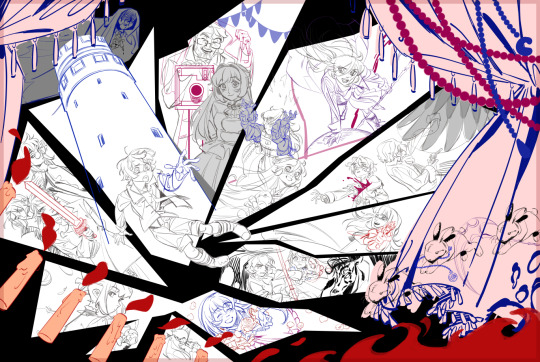
This drawing simultaneously took SO long but I also sped through it?? I had to like... not dwell too long on certain parts... like for example I think some individual character compositions really could be a lot stronger... because I knew this would be a beast of a drawing, I didn't want to spend an unnecessary amount of time focusing on details when I should be looking at the big picture. and I know that's a bad habit of mine!! I'm trying to unlearn my perfectionism!!
thanks for reading if you got this far, hope ya enjoy it!! and I hope I'll keep drawing Pandora Hearts in the future (clearly I haven't stopped since high school omg) and I hope to draw some more Vanitas someday beyond just chibis!
#my art#pandora hearts#oz vessalius#alice (pandora hearts)#gilbert nightray#elliot nightray#leo baskerville#vincent nightray#ada vessalius#oscar vessalius#oswald baskerville#lacie baskerville#will of the abyss#echo (pandora hearts)#alice baskerville#sharon rainsworth#anime north 2023#i think i doomed myself with this post on twitter bc i forgot you cant have words like “kill”#well. die algorithm die you miserable sack of potatoes 😭#edit July 2 2023: this post was really bothering me and i think it was hard to see the details on a horizontal composition#so i added a crop of alice to hopefully spice up the visual interest
1K notes
·
View notes
Text
Whitewashing in Anime - Agni ft. Cithis
Browns of the Same Shade
Hello again! I decided to revisit this topic again now that we have Agni's official appearance in the anime. I also wanted to go over some aspects that I did not get to include in my first post.
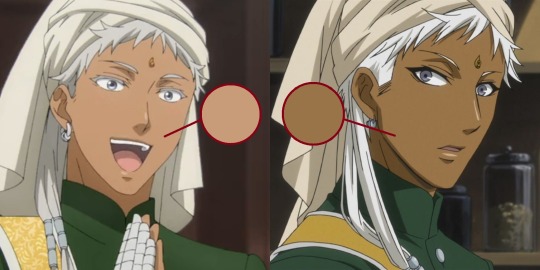
In the end, Agni also got lightened! His skin tone was always somewhat darker than Soma's in both the anime and manga appearances. Yana does describe his appearance as a "dark-skinned woman" in her genderbend sketches. So, for the anime to lighten him this much to such an degree is disappointing.
The skin diversity in the anime has been pretty lacking so far. Once again, A1 studios was not perfect, but they did manage to give all three Indian characters different dark skin tones, while this anime has every Indian generally the same lightened shade.

(every indian character in the anime are the same skin tone... cloverworks stand up, you can't let a-1 studios beat you like this)
Personal opinion of mine, I feel like animation studios aren't willing to play with skin color values as much anymore. I remember even seeing white characters being various shades of brown, especially under certain lighting and environments. Unlike now, when every character looks bleached the second they hit the sun.
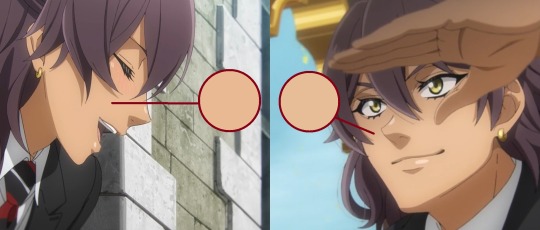
I also wanted to review what I think of Soma's appearance. Soma's skin tone isn't any darker than it was in the teaser shot sadly, so we can't blame the lighting. I already was expecting it, but it's still a shame.
One positive feature I'll give to the anime is that Soma's nose isn't pronounced all the time. In certain scenes, his nose isn't as sharp as it would be for other characters. I believe that's just the style for the anime and its dependent on the shot.
Anyway, I felt this image was pretty on topic with Soma and Agni's situation and just anime remakes/reboots in general lately:
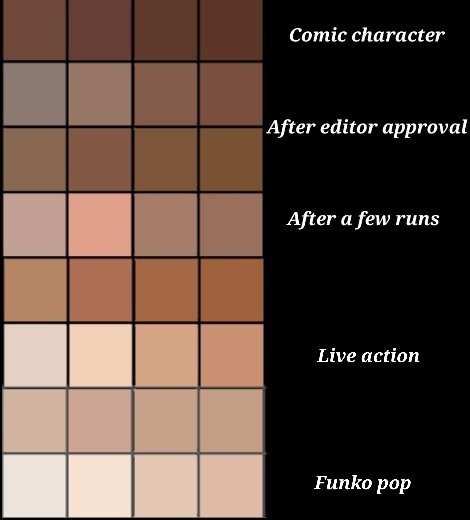
Brown ≠ Grey
Something I'm embarrassed I forgot in my last post is saturation! I mentioned often how darker skin tones tend to be neglected, but not only that, but the color! The vibrancy in the skin, the life!
A common feature I noticed, especially in East Asian media, is how they avoid the "brown" in dark-skinned characters, by constantly making their skin tone duller, ending up with more grey-toned skin.
I often see art advice for digital artists that they should pick desaturated colors or colors in the "grey zone" as to not overwhelm the art piece. Which is fine most of the time! But when you apply that advice for brown skin, what you get are mostly grey tones, and end up having your character look like a zombie.
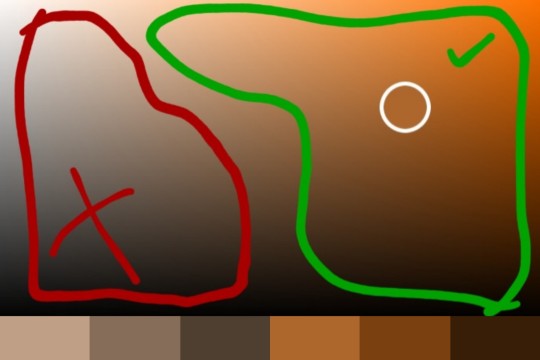
Here are some colors I randomly picked. The colors on the left are those sandy, dull grey tones I was talking about. If you want to get those richer, deeper-toned browns, you need to pick colors with more saturation like the ones on the right.
Now of course, color is relative and you can't just color pick your way around without considering how it fits in with the rest of the piece. You can even end up washing out your brown character despite choosing a strong brown color. You have to consider the background, lighting, undertones, the environment, and how they'll affect your character. There may even be times desaturated colors work better, but you have to at least consider why it works "better".
Let's take a look at everyone's favorite manga artist right now, Ryoko Rui! Ryoko Rui is praised often for her diverse character roster and creature design, however I always found her darker skin tones rather... lacking, as such for the elf Cithis.

(I color picked her skin tone and it matched my light grey shades above lol)
Her skin tone is very washed out and grey. She not nearly as dark as she appears in the manga. Once again, there's that dissonance between skin tones. Now take a look at the manga's grey tones.

When you see this, what skin tone do you imagine for her? Do you imagine the greyish, washed out tones from above or do you imagine something more akin to these black fae models I found?

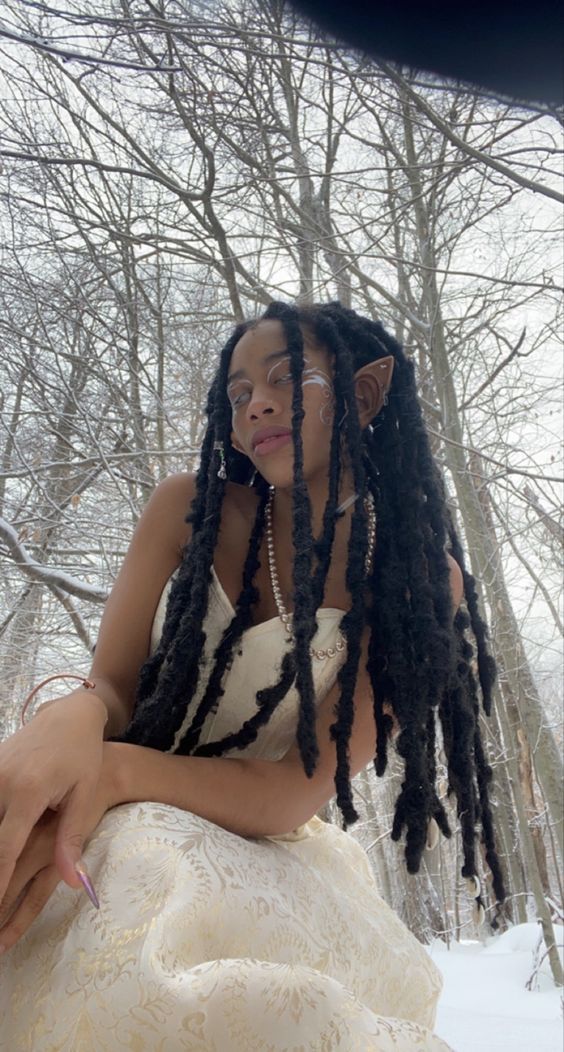
(credit: @jaharajayde on twitter and @glassmarigolds on pinterest)
I'll give Rui credit that her color illustrations of Cithis improved and she's gotten better giving Cithis stronger undertones. I really like how the fandom has been illustrating her too, there's been some amazing fanart of Cithis such as these (the lighting in the last one is lovely).
Just adding saturation helps so much with skin tone. I even found an fan edit of Soma that added more color back into his skin, and he looks so much better for it.
One might say, "Oh what's wrong with having grey skin tones in a fantasy story!" Well... nothing really! You can have green or purple or blue characters if you like. But when there's already a startlingly lack of brown characters in a fantasy story, it can get awfully uncomfortable seeing the story portray different fantasy "races" with obviously non white racial features... but don't want to include any black/brown skin tones.

(fantasy artists would sooner give an orc dreads than a human, forget a "noble" creature like an elf... such decisions only reveals the artists' viewpoints)
It all just comes back down to avoiding that dreaded "brown". When it comes to these "reasons", we have to question whether they aren't just more excuses to not include black and brown people in stories, which makes me come to my next point:
Essence of Brown
There's some severe misinformation I want to address about Soma. I saw a fan a while ago say that Soma has a white mother which explains why he has light skin.
Firstly, that information is false. It was a concept Yana had for Soma, but quickly decided to drop it. Soma is not half white.
In the early drafts of the series, Soma had a white mother and, thus, white skin. However, this was later omitted in final revisions.
(quoted from the official kuroshitsuji wiki as an excerpt from the character guide)
Yes, you can have mixed parents and any kind of skin tone really! But it feels... dishonest to create "reasons" why the manga's first major Indian character, joining a cast of white people in a European country, should have white skin as well. Especially considering Yana's artstyle, without Soma's skin tone and Indian wardrobe, is his physical characteristics like his face even distinguishable enough for him not to be mistaken as white?
Imagine I wrote a story set in France, and teased an appearance of an African character in story that only had white characters until now, only for him to be completely white in appearance, and identical to every other white man, except for the occasionally exotic dress and other drab stereotypes.
What would you think? That his race is only a dressing to fulfill an exotic need at times? That he's a supposed homage to another culture, but it's wrong to have him actually look like the majority of people who made said culture? Why is he even this way?
Did he have a white parent? A white upbringing? Lived in a white culture, lived a white life? Maybe he was separated from birth! From his hometown, his country, his people, anything to justify why my "brown" character is so divorced from that part of his identity, from that side of the family whose skin tone runs a little too dark.
And I think that's why Yana decided to drop the concept of giving him a white mother. Why go through all those loopholes and explanations? Why all that justification for him to have white skin?
It's just another way to avoid the "browness" again for a character, what makes them brown in the first place and related to black/brown cultures. It's what we should consider in the future when we find ourselves coming up with "reasons" why black/brown characters should be anything but themselves.
Whitewashing in Anime - Soma ft. Usopp
#awgh so many links#this was floating around in my drafts for a while#glad i can get it out now#i really wanted to address the white mother rumor#soma asman kadar#agni#b.txt#yana toboso#kuro#kuroshitsuji#kuroshitsuji season 4#public school arc#weston arc#cithis#dungeon meshi#ryoko rui#dunmeshi#racism#whitewashing#fandom racism
151 notes
·
View notes
Note
I understand if this is outside your field of expertise, but do you think if the ornamentation of the clothing that (some of) the kobolds drawn by Kui wear is inspired by anything?
Actually this is exactly my field of expertise! I studied costume design for about two years in university before switching to something else :) So clothing is something I love looking at and talking about, and fashion history is one of my favorite elements of history in general!
HOWEVER, though I have some experience with subject, I'm not a fully trained expert in the field, and I know that I may not have all the answers, so please take what I say with a grain of salt. This is only my educated guess.
I'm assuming that you're talking about this page from the Daydream Hour book:

To start with, the caption says: "Kobolds that appear in foreign games and fantasy often have a reptilian appearance, but we chose an appearance that is more familiar in Japan." This doesn't tell us anything about their clothing, but I wanted to translate it to make sure it didn't say anything about their culture.
(You can read more about why the Dungeon Meshi kobolds are dogs in the Half-foot chapter of my Dungeon Meshi research project)
Kobolds likely live all over the world, but their large population centers are all located in the Western Continent, so that is probably the region they consider home.
So those two kobolds on the bottom left of the chart, who appear to be wearing European-inspired clothing, are probably living somewhere in the Eastern hemisphere, where Northern/Western/Central/Eastern European clothing is the norm, while the rest are likely from the West. So we can discard the European-looking clothes, since that's probably not a part of the kobold's traditional culture.
We have very limited information about the Western Continent, but these images plus what we know about Kabru (His name and Utaya's name are both South Asian, the dessert that comes from Utaya is South Asian) and the elves (several of them have South Asian names, some elves wear South Asian clothing and bindis) makes me think there's probably a strong Indian/South Asian influence in the Western Continent. It's a large land mass, so I don't think it's all South Asian, but South Asian culture is the only thing we have conclusive evidence of so far.
The majority of the kobolds are wearing brightly colored tunics with patterns on the hems, or what seems to be dresses/tunics made of draped fabric, also with hem decoration.
It IS worth noting that Kui avoids drawing elaborate patterns, even when it would make sense for her to do so. She does it only a couple of times in the manga and uses screentones instead whenever possible. So the simple hem decoration and single color fabric may just be an artistic choice that doesn't mean anything other than "I didn't want to draw a pattern." However, it's all we have to work with, so I'm going to assume it's intentional.
The repeated over-the-shoulder draped fabric the kobolds are wearing seems like it could only be a Greco-Roman style toga, palla, or cloak, or a South Asian saree. We have seen Western elves wearing garments similar to all of these on occasion, though obviously Kui has made some changes. As I say in my essay, I don't think any of the cultures in Dungeon Meshi is an exact copy of a real-world culture, Kui is remixing things together.
(Except for the Island of Wa, which seems to be entirely based on Sengoku-era Japan.)
Roman togas were just large pieces of cloth that they draped around their bodies, and they were usually white, with brown or black reserved for the lower-classes or for use during mourning, and purple or red reserved for extremely important people. Embroidery and trim, if they had it, was usually either very simple (plain colored stripes) or very elaborate (images of people, animals, or things).
So I think that rules out the toga as a possibility.
On the other hand, the saree and dupatta are also large pieces of cloth draped either around the body and over the shoulder (and sometimes the head), and usually they are either a single plain color, a plain color with a decorative trim, or an all-over pattern. This is a lot closer to what Kui draws the kobolds wearing.
(Pictures and more text after the cut)
Toga:


Saree:




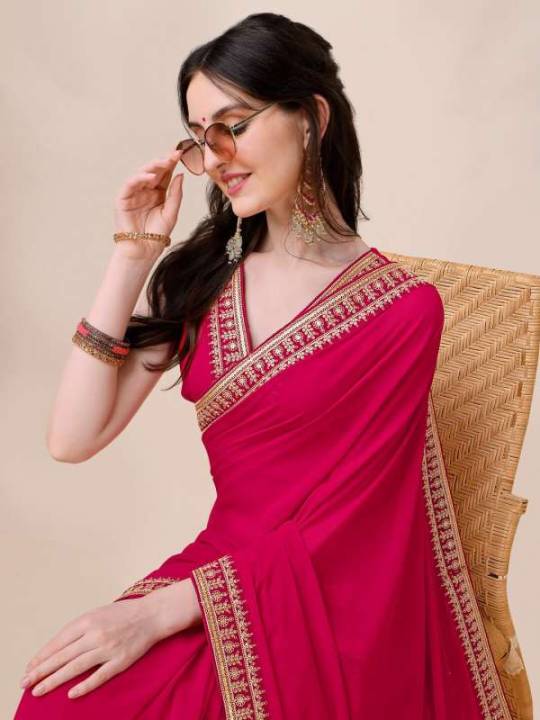

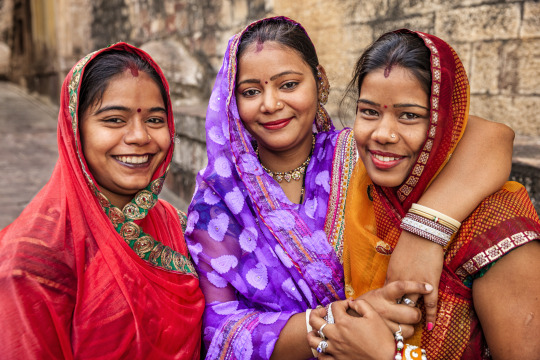


The tunics the kobolds are wearing could be many things, as what's visible is not an uncommon neck shape. They could be something like a kurta, kaftan, or abaya (tunic/robe)... And there's probably a dozen other similar garments that I'm neglecting to name.
There are a million variations on the kurta, but these neck styles looks like what Kui is drawing on a couple of those kobolds.



However, some of the tunics COULD also just be a depiction of what is often called a "Viking tunic" or kyrtill (Nordic name for a kirtle or tunic).

However in Dungeon Meshi, the kyrtill is extensively worn in the Eastern hemisphere, primarily by dwarves, tall-men and half-foots. So I don't think the Western hemisphere kobolds are wearing them, and the style of trim looks different to me than what Kui drew.
Kobold fashion could also be influenced by any culture from North Africa, West Asia, or the Middle East, as these are also cultures that appear to dominate the Western hemisphere of Dungeon Meshi, and that have similar fashion cultures involving patterned textiles and draping cloth/veils/head coverings...
However, because of what seems like a large draping cloth over the shoulder, and the combination of trim with a solid color, I think the primary influence is South Asian rather than these other cultures.
I hope that helps! And keep in mind that Kui loves to remix things, so I'm sure there's elements from other cultures that would fit right in with what she's shown us of the kobolds, if you want to get creative with your fan works!
#dungeon meshi#delicious in dungeon#dunmeshi#kuro dungeon meshi#kobolds#analysis#talking mushroom#The Essay
54 notes
·
View notes
Note
You write unhinged Leo so well, and I really like how you write him. I was wondering if you had tips on unhinged characters 😂, or do you just get inspro from existing characters 👀
aksdakjsdh thank you so much ;w;
And honestly???? I’m not totally sure how to give tips— but I love, love, love unhinged characters in media, so I’ll use them as examples

(long rant below lol)
I’ve always been a big fan of silly, ‘crazy’ characters in animated movies and cartoons. I grew up on Batman the Animated Series and the original Teen Titans, which were full of silly, fun tragic characters.
Don’t get me wrong, i love a good edge-lord— but as a tot i thought the colorful, theatrical, insane bad guys were more fun to watch than the big scary serious ones (ESPECIALLY if they had a good villain song. A+ good shit)
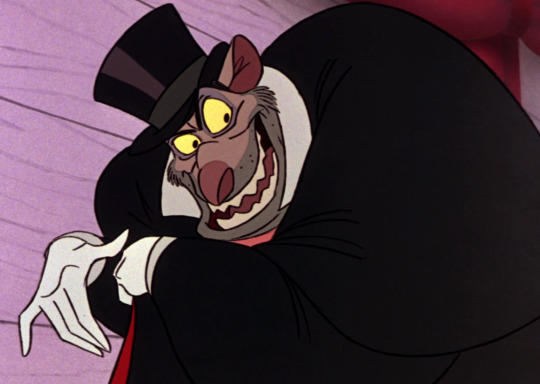
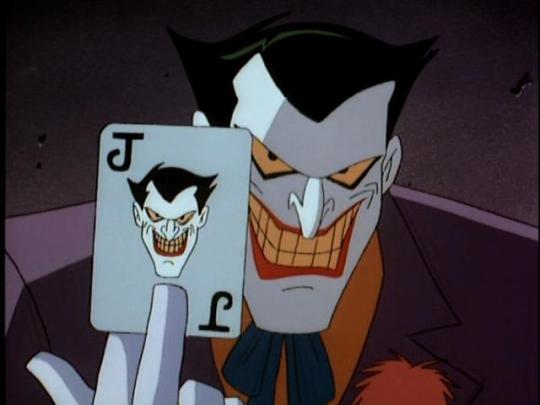
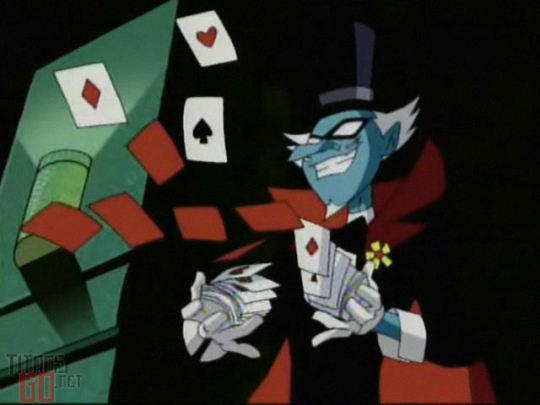
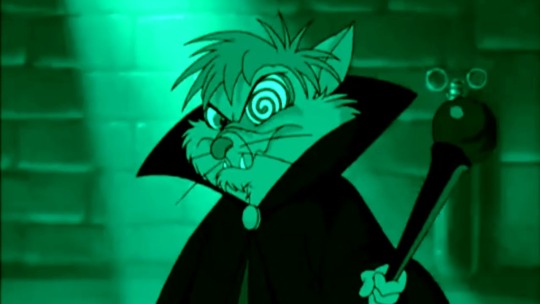

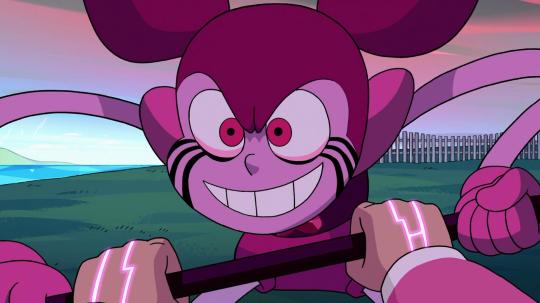
(From left to right: Ratigan from Great Mouse Detective, Joker from Batman the Animated Series, Mumbo Jumbo from Teen Titans, Martin from Secret of Nimh 2, Bill Cypher from Gravity Falls, and Spinel from the Steven Universe movie)
And not just bad guys!! There are a ton of unhinged good/neutral characters that i absolutely adore.

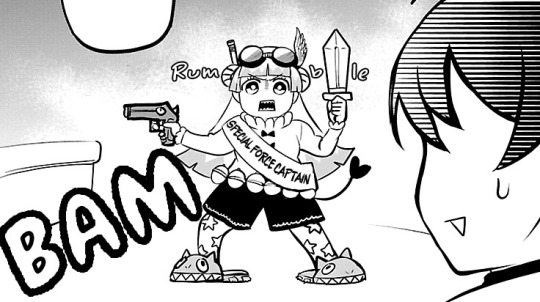
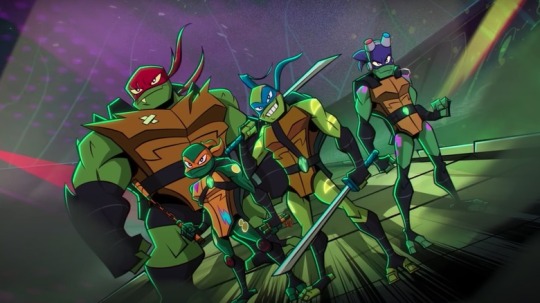
(From left to right: King Bumi from ATLA, Clara from Welcome to Demon School Iruma-kun, and, of course, our silly 2018 turtle boys)
((There are many more characters in both categories, but I’ll slide these examples in here for now))
My personal brand of “Unhinged” or “Crazy” characters definitely leans on comedy. That’s what i enjoy seeing and reading! I personally like it because it can help keep a story fresh and interesting. There’s an element of surprise and unpredictability with what a character might do, and i love that!!
I also really enjoy a touch of feral behavior in my unhinged characters. The lack of clarity and the danger that imposes can be a very fun tool to use, no matter the character’s moral compass. (I’m feral for feral behavior lol)
And impulses. Whether a character has a few screws loose or is generally a goober, they like to act on impulses. This often goes hand-in-hand with comedy, and that’s something I enjoy!! We get a lot of moments like that in Rise, and that was one of my favorite parts of that TMNT iteration.
But as far as writing goes, it’s been tricky for me. All of the characters I grew up or love have been visual— trying to find a good balance for reading has been a puzzle I’ve been figuring out as I go.
I read a lot manga (lol nerd) and comics, and I love how thoughts/dialog are depicted. Especially the really dramatic or impactful moments. (I’d add examples but I’m already at the Tumblr image limit LAME)
As strange as it sounds, I try to capture that “impactful visual” style in my writing. If I had ANY advice on writing unhinged characters, pay attention to pacing—
Short. Fast. A calculating thought. Perhaps a run on sentence that lacks punctuation to represent the rushing and disorganized thought process. A question? An answer with little thought. Is this moment amusing; describe how. Is it upsetting; describe how. Are the thoughts starting to scatter? M aybe s o…
Big moment statement.
Action or plan of next big move. Flow should never seem too uniform. Even in normal writing. Don’t be afraid of accentuating— but don’t overdo it. Remember, unhinged characters are impulsive. Have fun with that.
Just as a quick and dirty summary— when it comes to unhinged characters, I like to use comedy, feral behavior, and acting on impulses. I also like to keep it as visually appealing as possible for characters to give the eyes a little treat after reading walls of text. I like to use fun text formatting to help with the fun too (But don’t overdo it! Don’t make it feel like a chore to read) (<- says the girl who goes into way too much details sometimes lmao whoops)
But ultimately— have FUN!!! Unhinged characters are fun, so make sure you have fun writing/drawing/creating them!!
#BIG CRY THANKS#thanks for coming to my ted talk lol#hopefully this was somewhat helpful ;w;#or at the very least fun to read#I’m so glad people seem to enjoy how I’m writing Leo#because this is the first time I’m writing ANYTHING like this#pastel prattling#I’m sure as soon as i post this I’ll think of more obvious characters#but take this for now lol
82 notes
·
View notes
Text
Winter 2024 anime, Pt. 2: Mixed reactions, the bench, and the gems
hey y'all, this is also up on my ko-fi! it's free to read both here and there, but i'm struggling financially rn so i could appreciate if you'd throw a few bucks my way if you liked it! part 1 can be found here.
And we're back for part 2! Here's all the new stuff I finished this season, and one more I'll get back to later. As with before, these are sorted alphabetically within each category and are not ranked as of yet.
Also as before, the OP for each series is linked in the title. Check them all out if the header images aren't giving you the right feel for each show, but also check them out because most of them were actually pretty damn good this season.
[Solo Leveling OP voice] LET'S GET IT!
Mixed Bags:

Hokkaido Gals Are Super Adorable!
Your standard, quasi-harem “easily flustered Regular Guy wins over hot girls just by being really nice” shonen romcom. I really don’t have much to say about this one other than if you’ve seen My Dress-Up Darling, you’ve basically seen this already. The only thing that really sets it apart is the setting.
Tsubasa (voiced by Nobunaga Shimazaki, in a FAR cry from his turn as Mahito in Jujutsu Kaisen) is a straight-laced Tokyoite whose family situation lands him in a small city in the frozen boonies of Hokkaido. While looking for the bus to his new house, he runs into a gyaru in the snowy wild, the underdressed, hilariously-proportioned Minami, and they hit it off. It turns out they go to the same school, there are other cute girls there who take a shine to him as well, it’s nothing new.
I ultimately don’t have much to say about Hokkaido Gals, but I do have a soft spot for series like this, and after reading ahead in the manga I felt obligated to see it through. This is all junk food, but it’s all stuff you’ve seen done better in other series. I also have a soft spot for gyaru in anime and manga, and while I do like Minami just fine, she isn’t Marin Kitagawa or Rumiko Manbagi. I don’t really have it in me to recommend this show to many, though, at least not until another season rolls around, if that ever happens. The manga genuinely does get a lot better as it goes on, but the really worthwhile stuff may not happen until a third season, and I just don’t see that happening.
The manga has issues that the anime isn’t willing or able to solve, chief of which being the visuals. The art style of the manga is wildly inconsistent, and getting a mediocre animation team on this didn’t help matters at all. While the colors often pop nicely against the pretty, snowy backdrops, nobody looks all that great overall. The characters are recognizable, but they just plain don’t look great a lot of the time, nor do they look consistent from one cut to the next; I said that Minami’s proportions are hilarious, but just as hilarious is how wildly they vacillate from one scene to the next for the sake of trying to titillate the viewer.
My biggest takeaway from both the manga and anime was everything I learned about Hokkaido in the process, and if the series is taking subsidies from the island’s tourism bureau, then it’s a job well done. I want some goddamn jingisukan now. The OP is a great time, though. I’m shocked it took over a decade for us to get a proper “Uptown Funk” knockoff in an anime.
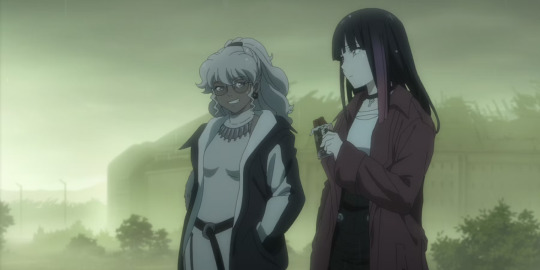
Metallic Rouge
I’ll be upfront in saying that this was my biggest disappointment of the season by far. This show had so much going for it, and what we got was… ugh.
There was an unbelievable amount of promise from the outset: This was Studio Bones’ commemorative 25th anniversary production, and coming from the studio that gave us all-timer adaptations like Fullmetal Alchemist Brotherhood and Mob Psycho 100, not to mention later works from Cowboy Bebop creator Shinichiro Watanabe (including the Cowboy Bebop movie), you can’t fault anyone for having high expectations. It looked to be a fitting production as well: Watanabe’s influence shines through immediately in the gorgeous, lived-in cyberpunk off-world locales and racially diverse cast. Action takes the form of dope robo-tokusatsu transformation fisticuffs, and it’s entirely in 2D animation to boot. The first couple of episodes were killer, too; everything looked and sounded amazing, and there were just enough plot threads teased out that I just had to see how they’d unravel.
It brings me no joy, then, to say that Metallic Rouge collapses into a jumbled mess. I don’t even want to bother talking about what happens in the show because I don’t fucking care anymore. There are few media experiences more sobering than to have it dawn on you over a span of several weeks that “oh… this isn’t actually all that good, is it?” Episode after episode piles on with sloppy lore, weak worldbuilding, warring factions whose names you immediately forget, pointless double-crosses, and the most predictable twist you’ve ever seen. For a while I was willing to accept the fact that I didn’t know what was going on half the time and expected things to become clearer, but now I’m not entirely sure the writers knew either. The stakes apparently kept rising and everything just kept getting more claustrophobic. I’m glad it’s over, if only because if I had to hear “Clair de Lune” one more fucking time, I was going to go ballistic.
There are several attempts at emotional beats, as the story is rife with tragedy and sacrifice, and every single one lands with a wet thud. Nobody gets enough time, motivation, or characterization for any of these things to feel like they actually matter, and that’s especially a shame because the finale might have been able to stick the landing if the previous episodes were less dense and better paced. Emphasis on “almost,” though, because just before the season ends, we get the absolute most pointless fakeout I’ve seen since The Rise of Skywalker, which is the lowest point of comparison you can make for any work of sci-fi.
This is especially frustrating because on paper, there is so much to like here. Rouge and Naomi are likable-enough deuteragonists with a fun dynamic, and they’d make easy yuri bait in a better show. The characters are all pretty and uniquely designed across the board, and the overall aesthetic, almost a pastiche of late-90’s anime futurism, is undeniable. The toku suit designs are neat and several of the action scenes are gorgeous. The score and soundtrack are outstanding (except for the aforementioned Debussy indulgence). I have few complaints about how the show looks and sounds; the style is great! All of my issues lie with the substance.
Metallic Rouge may have had all the ingredients, but it just needed more time to cook; whether that would have been by doubling the episode count or by more carefully planning the pacing and trimming some of the fat from the lore, I’m still not sure. Probably both. It probably needed better writers, too. Maybe it just isn’t as smart as it acts and there was no way to satisfyingly resolve the clumsy civil rights allegories that bring it uncomfortably close to the likes of Detroit: Become Human. So all of the above, I guess. I tend to adore stories that involve artificially-intelligent beings developing their own wills and emotions and learning to cut their own strings (the likes of Blade Runner, Nier Automata, even a couple of character arcs in the Persona series), but this ain’t it. I’m not even mad anymore. I’m just disappointed.
If there are two positives that will stick with me, though, they would be the absolute banger of an OP and, of course, Naomi Orthmann herself (pictured above, left). Outstanding character design. I’m mildly obsessed. She deserved a better show.

The Unwanted Undead Adventurer
This one isn’t even worth talking about, so here’s a brief synopsis, then I’ll add some commentary, and then we’ll all move on with our lives.
Rentt, a beloved but mediocre adventurer in a fantasy town, gets lost in the mysterious labyrinth that all adventurers explore for personal gain, gets waxed by a dragon, and awakens as a shitty-looking CGI skeleton. He notices, though, that he’s able to level up better as a skeleton than he did as a human, and with the more monsters he defeats, the more he evolves into something closer to human. The rest isn’t really worth discussing.
If I’m being honest, I should’ve dropped this show much sooner. It looks kinda lousy most of the time, the plot (inasmuch as there even is one) is boring, character designs are forgettable (except for Rentt’s closest ally, Lorraine, holy hell) and it seems wholly uninterested in actually building its own setting. If it returns for a second season, I won’t be there, nor will I feel like I’m missing anything. Each episode felt like a chore to watch. I probably only saw it through because 1) I liked looking at Lorraine, I know what I’m about, and 2) I didn’t want to lump it in with the shows I did drop. The Unwanted Undead Adventurer isn’t as patently upsetting or frustrating as those three, but it just plain isn’t a very good show.

The Witch and the Beast
This show could have been so much more. I was drawn in by the gorgeous character designs and intriguing blend of Victorian gothic aesthetics and architecture with modern infrastructure, and very quickly disappointed by just about everything else. The first episode is an exceptional proof of concept, and almost everything that follows is an upsetting showcase of what could have been.
The story centers around Ashaf, a languid, chain-smoking agent of the governing church with a big-ass coffin strapped to his back, and his partner Guideau, a snarling hyena in a young woman’s body, as they investigate abuses of magic across the continent in search of nefarious witches. Guideau in particular has a bone to pick with witches, as the body they presently inhabit is the result of a witch’s curse, and they remain in furious pursuit of the one who cursed them. The curse can be temporarily undone by a kiss with a witch, allowing Guideau’s true body, a hulking brute confined to the coffin, to escape and wreak havoc. Meaning that on a few occasions we get a girl-on-girl kiss followed by a big dude wrecking shit. There’s also other investigations of serial killings, necromancy, and a cursed sword, and here’s hoping you like those, because the coffin breaks are few and far between.
This wasn’t great! By the third episode I had the sneaking suspicion that the animation talent on hand just wasn’t enough to support the aesthetic. While the character designs are exceptional, almost everyone looks awful in any shot that isn’t completely focused on them. This is especially true of Guideau, who looks so inconsistently off-model from one shot to the next that I’m still not entirely sure what they’re supposed to look like, and that’s kind of unforgivable when we’re talking about a main character. Everything looks too dim and too shiny at the same time, and action scenes look like shit more often than they look interesting. I can see so many flickers of something excellent (or at least really good-looking) in Witch and the Beast, and everything else that keeps those flickers from actually igniting makes it so much more frustrating to watch. Maybe just read the manga instead; the panels I've seen from it were uniformly gorgeous.
Actually, yeah, you should probably just read the manga, because for a season of anime, the pacing is atrocious too. It’s clearly trying to angle for a monster-of-the-week format, but each of these mini-arcs is a little too dense for a single episode, so multiple episodes are dedicated to these one-off curiosities, most of which do nothing to advance the plot or show off what the show does best. And if one of them isn’t particularly interesting, you’re saddled with it for the next two weeks like you've been stuck munching on a mealy apple. And I know you can only adapt so much in a 12-episode season, but the decision to end the season on a flashback arc and a lore dump was baffling. That’s not world-building, that’s lazy, and it made the show’s existing pacing issues feel that much more inane.
I feel like I was sold a false bill of goods. I can only imagine how the mangaka feels about this. Dull and uninspiring all around. What a waste.
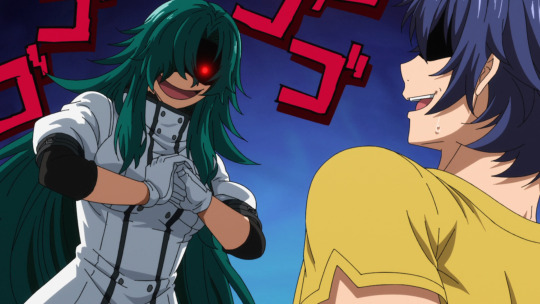
The Wrong Way to Use Healing Magic
Isekai, unassuming high school boy gains a unique power, impending war with the Demon Lord, yadda yadda yadda. The Wrong Way to Use Healing Magic isn’t anything new or special by any means, nor is it particularly well-animated or -paced, but at its best it’s silly and charming enough that it made a nice, brainless palate cleanser on Fridays.
Usato, your standard quiet high schooler, ends up walking home on a rainy evening with the popular, attractive student council president and VP, when an isekai portal happens. It turns out that it was just the seito-kai that was invited along for the ride (and President Suzune, as it turns out, is fucking psyched to get to be in an isekai), and Usato got caught along with them. When tested for magical aptitude, Suzune and VP Kazuki hit the jackpot with electric and light affinities, respectively, but things go awry when Usato’s reading turns up with healing magic. Terror strikes the palace as the intimidating dommy-mommy Captain Rose barges in to spirit Usato away from his new friends and into her squadron of goons to train him as a combat medic.
As character comedy goes, this one is actually pretty solid at times. Shogo Sakata is plenty of fun as the put-upon, lippy Usato (a much louder role than Chainsaw Man’s Aki Hayakawa), and Atsuko Tanaka (Major Kusanagi herself!) is a blast as the terrifying Rose, an uncompromising slave driver of a drill sergeant with a secret soft side. The dynamic between them is great, too; Usato is over Rose’s shit from the beginning and isn’t afraid to talk back to her, but before you know it, this transforms into friendly banter as Rose clearly takes a shine to Usato and knows he can handle any punishment she doles out. Suzune’s also a bunch of fun now that she’s broken away from having to be the competent, popular girl at school and gets to fully lean into being a complete dork.
Wrong Way also works decently as an isekai, because it makes an effort to stay rooted in high fantasy rather than fall back on JRPG mechanics, meaning there are no stat screens! It also avoids the trappings of wish-fulfillment isekai series by having Usato start out as a regular-ass guy; he’s not a Kirito type, just someone Rose sees as a rough gem in need of cutting. There are no cheat skills or OP weapons or anything, just a kid training every day to get stronger so he can protect the people close to him, and that’s the kind of anime protagonist you should want to be.
For better and for worse, I get serious mid-00s vibes from this one; watch the OP if you don’t believe me. Some of the colors pop uncannily in that early-digipaint-era way, and the animation is pretty middling; the most fluid animation we see is whenever Suzune is acting like a creep. Much like those mid-00s anime, though, Wrong Way may have benefited from being weekly (or twice as long) rather than seasonal. There’s a ton of planting with very little payoff, and it doesn’t feel like the actual scope of the story has even been addressed yet. We don’t even learn why the series has the name it does until someone literally says it aloud in the 11th episode. I may have to reevaluate this season after a possible second, if we ever get one, because this doesn’t stand too well on its own.
Of the anime in this “mixed bags” segment, I’d say I enjoyed Wrong Way the most, but it still had enough problems for me to keep it here. It’s not a particularly bad anime, but it’s not especially good either. I guess we can slot it into what Hazel refers to as “good mid.”
On Hold:

Cherry Magic! Thirty Years of Virginity Can Make You a Wizard?! (three episodes watched)
Man, what a title. That was the main draw for this BL series, which on paper is basically a gay version of the Mel Gibson vehicle What Women Want.
Adachi (a surname that will always make me laugh thanks to Persona 4), a gloomy salaryman, has hit the big 3-0 without getting any, and now he can somehow read anyone’s thoughts just by making physical contact with them. Just as he laments that this is his life now, he accidentally bumps into his handsome, popular coworker, Kurosawa, whom he learns has been harboring a massive crush on Adachi this whole time. Well dang, what now? Kurosawa’s a really nice, thoughtful dude, but Adachi’s never even thought about being with a man before! And isn’t there something wrong with already knowing this secret? How can he even go into the office and look Kurosawa in those big, handsome eyes… every single day…
What I’ve seen so far has been pretty solid, if not particularly well animated. The visuals are really my only gripe here; I just put it off for way too long and didn’t have it in me to finish it on time to actually get this thing written and published. Yaoi isn’t my forte, which feels like a shortcoming on my end as a fledgling bisexual, and I’ve already remarked on the solid LGBT representation this past season, so I do plan on hopping back on this one.
I gotta say, the co-leading voice actors put in serious work this season. Adachi is voiced by Chiaki Kobayashi, who continued his role as Stark in Frieren, returned to Mashle as Mash Burnedead, and contributed to Metallic Rouge’s cluttered cast as Noid. Kurosawa’s seiyuu, Ryota Suzuki (of whom I’ll always be a fan for his masterful turn as Yu Ishigami in Kaguya-sama), also held down leading roles in Bang Brave Bang Bravern and The Unwanted Undead Adventurer. They’ve been great in the few episodes of Cherry Magic! that I’ve seen so far, and they’ll be a huge part of what brings me back.
The Gems:
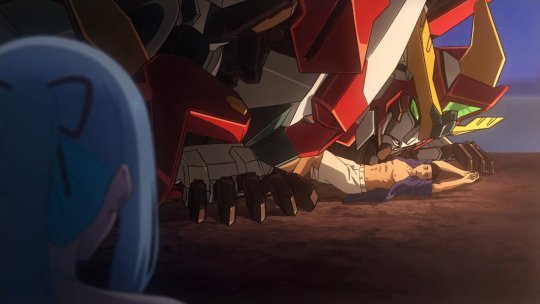
Bang Brave Bang Bravern
I feel like the mark of a perfectly audacious piece of media is in the moments where I find myself incredulously shouting “WHAT THE FUCK AM I WATCHING” at the screen, and Bravern made me do that at least once per episode. I have so many things to say about what makes this show great but all of it can be summed up as “it fucks so goddamn hard.”
A joint military exercise in Hawaii between Japanese and American mech pilots goes south as a sudden invasion by metalloid aliens portends certain doom for humanity. Just in the nick of time, though, a bombastic, autonomous mech named Bravern arrives from space and insists that ace pilot Isami Ao take his reins. Isami reluctantly agrees, and to his consternation, Bravern goes full tokusatsu on everyone’s asses, complete with fully-diegetic theme music, and keeps the threat at bay. With Bravern continuing to pester him to act as a pilot, Isami is forced to take up the mantle of a reluctant hero as everyone rallies around Bravern to save Earth. Tagging along is blond-haired, blue-eyed American pilot Lewis Smith, who gets to live out all of his Top Gun fantasies, right down to the latent homosexuality.
That last point isn’t a projection or anything: This show is legitimately gay as hell, and it rules. Bravern’s feelings towards Isami feel far more romantic than what you’d expect from a literal robot, and his description of how it felt to have Isami pilot him for the first time, as relayed to a grim-faced military council, is riddled with hilarious innuendo. Isami struggles not only with shouldering the burden of needing to be a hero to all of humanity, but also being beset on both sides by a loud, insistent mecha and a dewy-eyed gaijin, both of whom very well seem to want to get in his pants. Intricate rituals punctuate Isami and Lewis’ angsty relationship as these broad-shouldered, muscular men grow ever closer. It’s also worth reiterating that Isami is voiced by Ryota Suzuki, who also voiced Kurosawa in Cherry Magic!, and that may not have even been his gayest role this season. I’m not super well-versed in mecha as a genre, but I do know that there’s a lot of Warrior’s Bond-type stuff in these series, and Bravern lays it on thick. And hard.
This show looks killer, by the way. CGI implementation in 2D anime is still a touchy subject, but Bravern features some of the best I’ve ever seen. Simple cel-shading goes a long way to the point where, outside of some uncanny motion, Bravern himself feels perfectly blended into the hand-drawn animation. Mecha designs range from realistic military-style tech to otherworldly sentient robots, and battle sequences run the same gamut as the stakes rise. As goofy as all of the above may sound, it’s committed to being a grandiose, big-time mecha showcase.
This is as good as camp gets in anime; Bravern does for the mecha genre what Akiba Maid War did for yakuza film pastiche (I have also heard positive comparisons to Samurai Flamenco, which I’ll have to get on ASAP). It’s an excellent mecha show in its own right, and wildly hilarious to boot. Bravern himself is very genre-savvy and seemingly a bit of an otaku himself; he loves acting like a mecha hero, to everyone else’s chagrin. Several of the villains (also mechanical beings, voiced by an all-star seiyuu roster that includes Kenjiro Tsuda, the aforementioned Atsuko Tanaka, and Rie Kugimiya) are total dorks themselves. A CIA interrogator tries to waterboard a mecha at one point. Bravern is a deeply silly show, but its heart is planted as firmly on its sleeve as its tongue is in its cheek: For as wacky as it can get, the story still unfolds with a straight face and excellent emotional beats.
This show also has the most unskippable ED of any anime since Chainsaw Man dropped a new one every week. I will not say what happens. You cannot predict what it is. Just watch it. One of the top YouTube comments on that video says “When I saw this ending after episode 2, I thought I was going crazy.” That’s a ringing endorsement.

Chained Soldier
On the heels of 100 Girlfriends completely rewiring my brain, I was raring for some more good old-fashioned anime trash. I was told that there would be plenty this season, but you can consult the “dropped” section to see how well that worked out for me. Chained Soldier came with some significant hype, and soon enough into the first episode I realized that I’d actually skimmed through this manga before (don’t ask why), so I was on board immediately. Now here’s some nice trashy fun.
The world is in peril thanks to creatures called Shuuki that can advance on our world via portals from another dimension. Women primarily lead the charge against these monsters, as this dimension produces a special fruit that can lend them (and not men) otherworldly powers to help them in the fight. Yuuki, a perfectly normal young man, ends up in grave danger as he stumbles into a portal, where he is saved by the beautiful Kyouka, a commander who is able to subjugate Shuuki at will and use them to fight others. In a bind, she asks Yuuki if she can subjugate him, which he agrees to by licking her finger and transforming into a monster himself, at her beck and call. Because of his utility in battle, Yuuki is enlisted into her squad of baddies (and also an 11-year-old), living in their home as a caretaker and answering directly to Kyouka as her “slave.”
I know. Hear me out.
I put “slave” in scare quotes because Chained Soldier fortunately isn’t going full Shield Hero on us; this arrangement has a give-and-take baked in. See, every time Yuuki completes his service, Kyouka (or whomever else takes advantage of this anomaly) is compelled to carry out whatever suitable “reward” springs from his unconscious, and this is where the ecchi kicks in. Sometimes it’s a kiss, and sometimes it’s something a little more; the reward corresponds to the length and intensity of Yuuki’s contributions to battle, so the heat can turn up in the form of, say, clothed face-sitting, a good scrubbing in the bath, or some nice, casual CBT. All of this is to say that “slave” is a bit of a buzzword here: It’s more of a dom/sub situationship with a lot of extra steps.
Yes, just about everything that isn’t an action setup is full-on harem trash, and Chained Soldier lays it on thick, right down to full-on nudity. Nothing about this show resembles high art, but I can’t help but admire such a high level of commitment to its aesthetic, including the sleaze. It fully commits to the bit and doesn’t even bother lampshading its own trashiness. Chained Soldier knows what it’s about, and I respect that. It also has the good sense not to sexualize the youngest girl, which is a point in its favor that I can’t award a couple other shows previously discussed.
And while this show is plenty fun, the action sequences often excellent, and the character designs usually delightful, there’s not actually a whole lot going on here. As I said with Mashle, I know that battle manga like this can take a minute to really get cooking, and as I said with Witch and the Beast, 12 episodes may not always be a sufficient runtime to adapt enough to break ground, but the debut season feels more like a proof of concept than anything else. That being said, Chained Soldier’s manga has a very effusive audience, and its praises don’t seem to entirely be about the boobs and butts, so I’ll wait patiently for the second season. I think it’s earned that much.
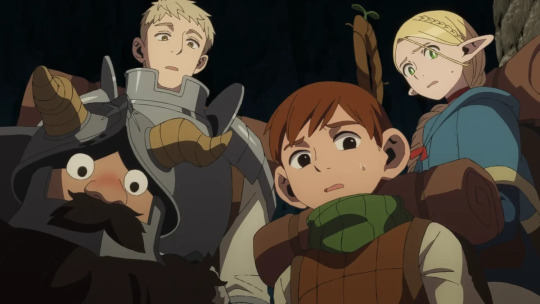
Delicious in Dungeon
This is the one I’m having the hardest time writing about because it so confidently and so completely speaks for itself that anything I could add would feel like scattering sawdust at the beach. Dungeon Meshi (I refuse to call it by its official English title) is a widely beloved manga among those who’ve read it, and for Studio Trigger to do an honest-to-goodness manga adaptation for the first time might as well be front page news among anime fans.
The story follows Laios, the deeply weird human hero, as he delves back into a bizarre and mysterious dungeon to rescue his sister Falin from the belly of a dragon, along with his misfit party: The neurotic half-elven mage Marcille, the temperamental halfling rogue Chilchuck, and the dwarven warrior-slash-chef Senshi. The party is frequently low on supplies, so to survive the trip they’ll need to subsist on the most abundant resource in the dungeon: Monsters. Senshi’s aptitude in the kitchen helps ensure that everything is edible and sufficiently tasty, regardless of how nasty the monster it came from may have been. With monster obstructions out of the way and their bellies filled, our party delves deeper into the dungeon as the mysteries deepen in kind.
I love the character dynamics in this so goddamn much. Marcille and Chilchuck are frequently put off by the dubious monster food presented to them, but their consternation is worsened by the fact that Laios’ fascination with the monsters it came from annoys the shit out of them. I referred to him as “deeply weird,” but that doesn’t begin to describe his absolute galaxy brain, and I mean it as a term of endearment. Laios is deeply knowledgeable and curious about the fauna in the dungeon, and not just how they taste: He is vocally curious about how certain monster attacks may feel, sings along with siren songs, and even keeps a hardcover bestiary inside his breastplate. He’s one of those people you turn to if you have a question on a hyperspecific subject, but you have to be careful how you ask it or else you’re trapped for the next two hours. And I love him for it.
Even putting the comedy aside, there is a fascinating human element at play in Dungeon Meshi, and I can tell that that surface has barely even been scratched yet. Marcille is just as dogged in her pursuit of saving Falin as Laios is, maybe even moreso (remember what I keep saying about LGBT representation this season?). Chilchuck continues to convince himself that he’s only in the job for his own personal gain, but you can see that mask slipping. And I still wanna know what Senshi’s deal is. Even with the five major players I listed, there’s an increasingly deep roster surrounding them—showcasing a broad spectrum of races and ethnicities, both real and fantastical—each with their own histories and motivations, and I cannot wait to see how they play out and interact with one another. There seem to be much deeper themes at play here as well as we learn more about perceptions and grudges between differing races, oppositional magics, clashing ideologies, and the monetary incentives that drive both the dungeon’s exploration and its very existence. I’m here for it.
I’ve been holding off on reading the manga until the season is up in June (though I could crack any day), but I know a loving adaptation when I see one. Not that Trigger ever slacks off in the animation department, but they absolutely brought their A-game here. Everyone looks bouncy and cartoony in the way only Trigger can pull off while still looking as close as possible to Ryoko Kui’s source material (as far as I can tell). As with Frieren, the action sequences aren’t frequent, nor are they entirely what the show is about, but they look incredible every single time. And the food, of course, looks incredible, no matter how weird. This is practically a cooking anime and a fantasy dungeon anime at the same time, and both aspects are visually on point at all times.
I’m obviously speaking from my own bubble as one of the six people who still use Tumblr in 2024, but I rarely see new anime make a splash like this on social media every single week, and the ones that I do are usually the monster shonen hits like Chainsaw Man or Jujutsu Kaisen. Dungeon Meshi deserves the exposure and success it’s attained, and I’m excited to see it continue. I’d easily slot this right up there with Bravern as one of the best new anime of the season.

A Sign of Affection
I’ve seen a hell of a lot of shonen slice-of-life romances in the past year and change, so a nice fluffy shoujo like this was an excellent palate cleanser. There were a hell of a lot of Big Action Setpieces and panicky teens and grim dungeon crawlers this season, and at the end of the week I wanted to unwind with a bunch of pretty twenty-somethings falling in love with each other.
The show centers on Yuki, a young woman living with congenital hearing loss, making do at a public college after growing up at a school for the deaf. Though she’s able to get by with LINE messages and lip reading, she’s unprepared when a foreigner asks for help, but she’s saved by a handsome and mysterious young man named Itsuomi. He’s able to help out, and takes an interest in her when he realizes his fellow undergrad is deaf, and Yuki takes an interest in kind because he’s really goddamn hot. It turns out that he’s a polyglot and an avid world-traveler, but sign language is not in his purview. This mutual interest sparks the concern of her childhood friend, Oushi, one of the few people in her life who already use sign language, who wants to be sure that nothing untoward is happening. And it isn’t, because this is just a really lovely, low-stakes romance story.
This is pure, unfiltered shoujo at its best. Yuki’s internal monologue is peppered with flowery prose, and everything and everyone looks soft and beautiful. Fashionable, doe-eyed women and pillowy-lipped ikemen abound (seriously, holy shit, the lips on these boys) as the scope widens and the main love interests’ friends explore their own possible love stories. Itsuomi is very much of the “mysterious boy” archetype you’ll find in romance stories in this demographic, but he’s not hiding any sort of dark past like you’d typically expect; he’s just an interesting guy who keeps his personal life close to the vest. He’s a self-appointed world citizen who loves learning about how people of all cultures live their lives, and in Yuki he sees someone within his home turf who happens to live in her own world entirely. And it’s easy to see his forward behavior with Yuki as infantilizing at first (Oushi sure does, and I’ll get back to him in a second), but as they grow closer Itsuomi quickly becomes much more considerate of her boundaries and learns to accommodate her as he studies sign language and gestures that help ensure her comfort. This is a story about Yuki’s horizons broadening just as much as it is about Itsuomi wanting to be let into Yuki’s narrow world, and that sort of synergy makes for some exceptional romance.
A Sign of Affection deserves some credit for refusing to shy away from Yuki’s disability and making a point of depicting her world as one that does little to accommodate her. Very few people in her daily life ever bothered to learn sign language, she relies on a friend to take notes during lectures, and work is hard to come by. It’s an honest depiction that makes an effort not to be exploitative, which is a breath of fresh air. Not only that, but there’s some interesting meta-commentary in there: The only major conflict in the story stems from Oushi’s jealousy, and his reservations about Itsuomi possibly “taking advantage of” Yuki almost feel like he believes that he’s the only one who knows what’s best for her just because he’s done the bare minimum to accommodate her. He thinks he’s coming from a good place, but he winds up accidentally infantilizing her in exactly the way he thinks Itsuomi might. That’s a particularly interesting bit of irony!
I’ve seen enough shonen-oriented romcoms where an unassuming Regular Guy gets flustered as a way-too-casual girl pushes his buttons (hell, I’ve already reviewed two of those this season), so it’s nice to see the formula flipped for a shoujo as Yuki and her best friend Rin blush and squee over Itsuomi and his coworker Kyouya, respectively. A Sign of Affection isn’t afraid to get a little silly with it, either; plenty of these moments are punctuated by characters’ faces going low-detail or full chibi, and they are cute as shit every single time.
This one was just cozy as hell. If you’re into this sort of thing, swaddle yourself in it and bask.

Solo Leveling
I let this one collect dust after the third episode and didn’t pick it back up until the season was almost up, and honestly, I was kinda dreading it: The trailers didn’t look too promising, the show was slow to start, and it looked like yet another derivative JRPG-style dungeon crawler that managed to get popular. Turns out, nah, this show actually kinda fucks and the web novel series and webtoon it’s based on are popular for a reason. The story is nothing special, don’t get me wrong, but it’s a perfectly serviceable turn-your-brain-off action spectacle with a bit more lying beneath the surface.
In a modern-day South Korea where portals to mysterious dungeons open up and threaten the populace, those who can brave the dungeons, known as hunters, are an invaluable human resource. Once someone is assigned a grade as a hunter, they have that grade for life, barring some rare occurrences. Sung Jinwoo is at the lowest rung on that ladder as an E-rank, incapable of improvement, assigned the epithet “the weakest hunter of all mankind.” He mostly shows up to portal raids as a warm body to fill a quota, and one such job goes haywire as most of the raid party, Jinwoo included, is brutally slaughtered in an arcane secondary dungeon within a portal. He somehow wakes up in a hospital, unharmed, and able to access a digital menu before his eyes that exhorts him to do the One Punch Man workout every day, lest he incur punishment. He gets hilariously chadly in the span of a few days in the hospital, including an inexplicable haircut, and finds access to dungeons only he can enter and levels up within this new system.
This one gets off to a slow start and may have benefited from a longer premiere like Oshi no Ko or Frieren, but once the table is fully set, Solo Leveling really starts to cook. Jinwoo’s titular leveling process is a blast from one fight to the next, and as he moves to work in the dungeons that other hunters can access, it turns out he’s been training with the weights on. He’s suddenly fighting way above his pay grade, and after staving off attacks from hunters taking advantage of portals for nefarious ends, he is recruited by an ambitious corporate scion to make some real coin and establish an independent association of hunters.
While it can feel like there’s a whole bunch of table-setting between portal sequences, it’s some smart worldbuilding on Solo Leveling’s end to establish how portal hunting became a central pillar of this society, and doubly so how political and capitalist interests can leave a wide berth for corruption and bad actors. If there’s money to be made in hunting, of course people will find ways to make even more at the expense of others, both at the corporate and individual levels. There’s a lot of talk in there about “survival of the fittest” and “natural selection” and that… makes me nervous.
Those are terms that can be used to justify immoral actions in the name of money, sure, but Jinwoo also uses them to justify his own process. To what end is he constantly improving himself? Sure, he's doing what he can to provide for his younger sister and their ailing mother, but I see less and less humanity in him as this goes on. There are constant hints at something far more sinister at play than just a dude getting stronger for himself, not the least of which being “the system,” the UI that implores him to keep taking on these “quests.” Something, or someone, seems to be guiding him. Whenever another hunter turns on Jinwoo, of course his self-defense instincts kick in, but system pop-ups instruct him to defeat X number of hostiles like it’s a normal video game scenario. There’s something eerily depersonalized about these encounters, despite them being full-on mortal combat, that gives me serious Ender’s Game vibes. Consider me intrigued.
I’d heard that the Solo Leveling manhwa’s main draw was its visuals, and though I had my doubts early on, I'm sold now. This is a pretty solid presentation! Hiroyuki Sawano turned in yet another banger soundtrack to punctuate all the action setpieces, helping to stitch together a fairly complete tapestry. Said setpieces are exhilarating and almost impressively bloody, and while the animation is nothing impressive in the day-to-day, it goes absolutely batshit when the gloves come off. Movement is inhumanly fluid and the visuals can go into the same loose, psychedelic territories we’ve seen in the likes of Mob Psycho and the second season of Jujutsu Kaisen. If this is the new meta for shonen action, I’m not complaining.
By all rights, this is a pretty decent show, but if I’m being honest, this one just hasn’t stuck with me much. And that’s fine! Sometimes I just wanna see some nutty action stuff and move on with my day. Solo Leveling hits that spot perfectly, and I'll be right back there when it returns for its next season.

‘Tis Time for “Torture,” Princess
I was surprised to learn that the gag manga this is based on, with such a seemingly simple premise, has been running for well over 200 chapters and counting. As the anime progressed, I was far more pleasantly surprised to learn that it actually works.
In a standard anime fantasy world where the forces of good are fighting the demonic Hellhorde, an unnamed warrior princess and her talking enchanted sword are taken prisoner and subjected to torture as they’re squeezed for intel. Said “torture,” as the title’s scare quotes would suggest, is mildly unconventional, as the demon baddie inquisitor, aptly named Torture Tortura, attempts to ply the princess by presenting her with tantalizingly delicious-looking food that she can only partake in if she coughs up some info. Naturally, the princess caves every single time, but her intel is often inane and useless, so the “torture” continues. It’s not all food, though: The princess is soon held out of arm’s reach of adorable baby animals by a gyaru beastgirl, pampered into submission by a spa-loving giantess, and is faced with a tsundere vampire faildaughter, who… tries.
And you’d think that would be it; the joke wears thin and you move onto something else. Before you realize it, though, something’s changed: The princess and her captors are quickly becoming friends. The premise almost feels perfunctory: These inquisitors are actual people just doing their jobs, and whatever happens after the princess’ myriad confessions is fair game. There’s no malice or animosity, even during the “torture” sessions themselves: Everyone will have a blast and grow closer as friends, and then the princess will voluntarily go back to her bedless cell. It’s like Sam and Ralph after they clock out, except they’re almost always off the clock. Everyone is genuinely looking out for each other in all directions, and the only thing that keeps the torture going is the need for a status quo to return to, even as it grows more elastic. If anything, Time for "Torture" is a good example of committing to the bit without having to necessarily rely on it.
The real irony in all of this is that it becomes increasingly apparent that the princess is having her needs met in captivity far better than she ever did back home. In her proud proclamations about how she’ll never cave to the temptations before her (shortly before she does just that), the princess often talks about her upbringing and her time as the head of an imperial legion, but these stories often betray her lack of friendship or any of the little things that make life worth living. Her life as royalty was one of isolation and deprivation, to the point where she finds more freedom and fulfillment as a prisoner. She truly lives in a society.
Hellholm, on the other hand, has a surprisingly healthy approach to things like work-life balance, food, and leisure, and its most valuable prisoner is no exception. The Hell-Lord himself is a surprising exemplar of this; for as much as he looks and talks like your standard terrifying JRPG demon king, he’s a surprisingly good dude! He looks after his family, employees, and even the captive princess as if they are all one and the same; he exhibits strong principles and an aversion to conflict, sees to his employees' needs and wants alike, and is a supportive, loving father to his unbelievably precious little daughter (who also serves as a “torturer,” to the princess’ delight). He’s also a big time anime dork, and even bonds with a knight attempting to rescue the princess over their shared otakudom before sending him off peacefully. As “villains” go, he’s top tier.
Time for "Torture" is nothing groundbreaking by any stretch, but it’s a cute, silly time and it plays with anime fantasy tropes in the same way a six-month-old German shepherd “plays” with a cheap stuffed toy. How long the premise holds up is entirely up to you, but I had a lot of fun with it. I have no idea how this ended up being one of the better shows this season, but I guess it just scratched the right itch for me.
111 notes
·
View notes
Text
Astro boy reboot, oh boy
So news of the new Astro boy reboot series broke out like WILD FIRE and as I predicted the fandom that has been waiting so long for it is very worried of how it'll turn out
But honestly
I'm actually quite hyped for it.
They removed the Miraculous creator from working on it which is a great start in my book THANK THE HEAVENS. Secondly I don't mind Astro having a girl he has feelings for at 9 as that happened in the 80s version and it was genuinely very sweet (ya know until she was found out to be a bomb and the two had to heartbreakingly seperate by her needing to be taken apart which destroyed the fandom's hearts). And he had plenty of crushes over the years so I'm not phased by it.
The only thing I hope for is that they don't make her human, because the problem with a robot child being together with a normal human child is the fact that she can age and he can't as he is permanently stuck with the mind and body of a 9 year old, so OOOO THAT RELATIONSHIP WILL BE *BAD* IN THE LONG RUN IF THEY MAKE THE RELATIONSHIP A PERMANENT THING AND NOT TEMPORARY.
Now to talk about some other things, I am actually really excited for the plot. It's a very slept on plot on the idea that Astro has to keep his robot identity secret from others to blend in as human and sometimes not even discovering he is a robot himself till later as usually unless told or shown otherwise Astro is mistaken to be a normal human child. That idea of self discovery and finding about who you are, who can from, and who you decide to be is a core trait for Astro and I find the plot as a cool way to show that.
And speaking of which, the elephant in the room. Tobio. By the looks of the plot it makes it known that Astro is gonna have the hero name be Astro when he is fighting and will most likely be called Atom by others AND I HOPE I PRAY TEZUKA GOD OF MANGA YOU BETTER HELP HERE I HOPE that they actually keep in and address the fact that Astro/robot Tobio is a robotic replacement by a father gone mad of his 9 year old dying in a tragic car accident as it's a CORE part of his character. The implication that robot Tobio has been living as a replacement in this series and is discovering himself and who he truly is by becoming Astro would be SO COOL
Lastly, the cgi, ima be honest it looks pretty decent. I like the way it looks as we could've gotten something so much worse if it was animated like Miraculous believe me. It looks bright, cartoony and colorful which ppl associate with it causing stir for it being aimed towards kids but the original Astro boy was also aimed towards kids in that same goofy cartoon style. What made it memorable was the story, the meaning, how a goofy and silly looking manga who could hold such darkness and truth and bringing to light deep societal and human issues while dealing with the inner turmoil of a boy trying to find out who he truly is beyond what he was made for. That he isn't a replacement, that he isn't just a robot. So as long as they are able or atleast TRY to hit that mark, then that's what matters to me more than the style.
In conclusion, it's just the pitch idea mind you, just a summed up concept. Everything is subject to be changed and tweaked as things get made and processed. For all we know it could end up being something completely different. The fandom has a reason to be on edge but we should be atleast a bit more open minded towards it until we see it in action it might not be another 2003 but it's definetly no 2009. And as for the ones working on it with both Tezuka productions and the fandom holding them at gunpoint over a series we've waited nearly a decade for, that better encourage them to give out one hell of a series.
Also Tenma and Oshan better be the same divorced science dads we all know and love or I swear to god-
#astro boy#mighty atom#atom#tetsuwan atom#astro#astro boy reboot#astro boy 2003#astro boy movie#astro boy 2009#astro boy 1980#tobio tenma#umataro tenma#professor ochanomizu#hiroshi ochanomizu#dr ochanomizu#astro boy manga#tetsuwan atom 1951#tetsuwan atom manga#tezuka star system#osamu tezuka#tezuka osamu#tezuka productions#dr tenma#manga and anime#animated series#tv series#manga series
42 notes
·
View notes
Text
kuroshitsuji s4e1/ED thoughts
ok yall now that it has been over 24 hrs and I've seen the ep over three times, I have THOUGHTS. mostly very positive, everything was beautful to look at and the 1:1 comparisons between the manga and the anime made me very happy as a veteran kuro fan that had to live through the mess of s1 and s2 plots (even tho they might have a sentimental place in my heart just because of nostalgia).
but i wanted to come on here and yap about the ending theme and how it encapsulates sebastian and ciel's complicated and very interesting relationship. idk abt yall but im a big fan of the op and ed this season!
first things first just to get this outta the way, I dont interpret them as a ship so please dont come in here with that interpretation 👁️ I'm serious .
that being said -
the ending theme is beautiful in both its animation and what it says about the butler and earl's relationship. I'm just gonna get the gushing outta the way first but it was aesthetically GORGEOUS in its animation. the way ciel fell so gracefully and the colors with SID's music is cinematic perfection. the change in animation style is very easy on the eyes as well! gg cloverworks animation team!
this has been marinating for a while, but what really gets me is the scene where ciel falls. he is falling into darkness, when it suddenly becomes lighter, with the sun illuminating the clouds. sebastian "saves" him and they fall together across this very pretty backdrop.

the demon might've caught him, but that doesn't prompt him to rescue ciel, to stop him from falling to his death.
sebas instead gently takes ciel's hand to guide him there. he gives ciel a false sense of security, of trust, catching the boy when he's at his darkest place, but instead of saving him, he drags him to down to his hell. he is deceiving ciel with a beautiful view and promises in their contract that will ultimately hurt ciel. its cruel and will only lead to pain for our earl.
sebas is a demon (obviously) who is leading ciel to his doom, but the path they take is twisted and tragic but strangely beautiful like the gorgeous sky in the ED.
ciel enjoys the power and omnipotence he has with sebastian, knowing full well the demon is leading him to his demise. he knows that this relationship will end him being sebastian's dinner. ciel knows he can't trust sebas, but does anyways because sebas is the only person who can't hurt him until he inevitably does.
the fall might result in an ugly death, but the view is pretty nice on the way down. the beautiful sky colored with deception, manipulation and misplaced trust.
yeah, sebastian will end up hurting ciel the most at the end, but the boy doesn't care at the moment. sebas is the only ""person"" who knows him with all the ugliness of his past, yet still protects him, serves him, and doesn't treat him like a helpless creature. so ciel is forced to place trust in a fundamentally untrustworthy creature knowing he is inches away from the demons bared fangs.
sebastian helps him survive his living hell now and get what he needs to get done, so he doesn't care what happens after. his descent to darkness becomes much more beautiful as a result.
shippers may have one interpretation (which I'm NOT a fan of...), but this is how I see it, and I think it makes this ending all the more impactful and tragic. but here I am, and I'm enthralled by the beauty and can't look away.
anyways, thanks for reading my brain dump, and looking forward to ep 2 folks!!! hope yall liked my micro analysis/semi organized gushing, and r enjoying this kuro renaissance as much as I am! here's a professor michaelis for reading this far
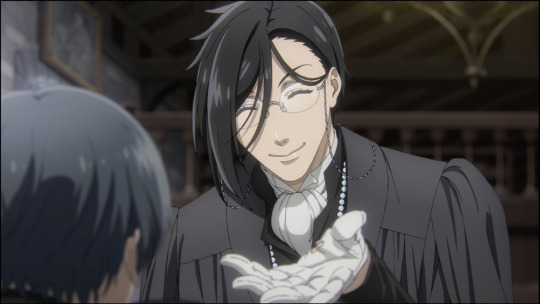
#kuroshitsuji#kuroshitsuji analysis#ciel phantomhive#sebastian michaelis#black butler#shoukuzai sid#professor michaelis#kuroshitsuji public school arc#kuro spoilers#kuroshitsuji s4#kuroshitsuji ED#do not tag as ship :/#not ship#my two cents do with it what u will#gateau au earl#long post
61 notes
·
View notes
Note
Hello, I hope you don't mind if I share a weird headcanon of mine 👉👈
I normally see people talking about Kakyoin make drawing about you but what if Jotaro does that too? The reason I have this headcanon because I remember the scene when Jotaro using Star Platinum drawing the fly he saw in the picture, and he draw it so well. It makes me think that maybe Jotaro has talent in art too. Jotaro's style will be realistic style while Kakyoin will be more like cartoon/anime style.
Imagine their sketchbook filling with so many drawing of you 💕 Jotaro will watching you from afar, sketching you with your cute smile, your beautiful eyes, he captured it all. For Kakyoin, I think he will even make up characters (oc) that look like you and him and ship them together lol (this headcanon inspried by my friend, she actually do that with her crush).
Thank you for reading my ramble, glad to talk with you :D I would love to hear your thoughts about my weird headcanon
P/s: Love you writing so muchhhh 💝
This is fun stuff, I could eat it up all day. Thanks for sending it in, so I can blabber my mouth about it
This always internally bugged me so I’m very thrilled that someone brought up how well Star Platinum drew that fly. I suppose it’s kind of easy to gloss over for a lot of people compared to Kakyoin’s scene of painting on that canvas. (Then again that fly was kind of important to identify to figure out where Dio was so then again it’s “???” for an explanation)
Anywho, I’d say signs point to Jotaro being able to draw, and I think it’s a hobby he prefers keeping to himself. Like you said of him having a sketchbook, almost no one sees what he draws in it and he doesn’t want anyone else to see it especially if it’s various sketches of you. So more than likely when he does do so, he’s somewhere where he won’t be pestered by school girls, or whatever punk tries to start a fight with him.
I’d also like to think he goes back and lingers on prior stuff, just staring at it for a little while. This applies usually when you’re out of school sick (which he’ll probably stop by later anyway with or without your knowledge). But there’s something comforting about seeing every piece of your visage in his sketchbook. Literally no one else knows about this sketchbook aside from maybe Kakyoin (Holly has her suspicions he takes a sketchbook around but she smiles not pestering her son on his hobbies as she thinks it’s adorable).
For the most part art wise I think Jotaro sticks to traditional art, maybe a dabble of charcoal but he prefers pencils. Maybe watercolor if he ever went beyond, but traditional with pencil/pen is the easiest way for him to pull something out at his leisure. Would he let you see? Maybe eventually when he gets you where he wants you, or if the cat is out of the bag early and you see it and you’re not quite with him yet. Let’s just say seeing that may speed up him taking you.
Kakyoin I could definitely see diving into the oc type of thing, he’d certainly reference an artstyle of a manga you like. (Don’t ask how he figured that out so quickly). Though he definitely loves putting some passion into his artwork and occasionally shamelessly make sultry artwork of you and himself. He loves painting the most as he spreads colors, mixing them into the wondrous hues that is your skin tone. Or splashing watercolors in a notebook, that looks something out of a fairytale. Soft and warm lighting….oops he’s getting a tad bit excited.
He definitely presents pieces that are obviously meant to be stand ins for the two of you. That no one else would ever be wiser too, yeah you might have this odd feeling something’s not quite right, but there’s nothing there you could really prove other than observe just how pretty the composition is. If you compliment it, that just fuels this man’s desire further.
Biggest takeaway here is Jotaro and Kakyoin very blatantly have their own styles whether sticking with black/white/grey, or full on color. Both would be pretty in their own right, and their style choices speak of their personalities without saying a single word.
#yandere imagines#yandere jjba#yandere jjba imagines#chitchatwithcrazyyandere#yandere headcanons#yandere kakyoin#yandere jotaro
67 notes
·
View notes
Text
Ateez’s Ideal First Date
Just some Thoughts™ as always hehe
Hongjoong: If he's asking you out, he likely already knows you decently well. Rather than an awkward dinner of small talk, Hongjoong invites you to an interesting activity like a pottery class or a paint night. Something where you can try something new and create something together, just sharing experiences with less pressure. To him, it's more important that you two can coexist in harmony than how well you dress up for a fancy meal! You know he’ll compliment your style on the unique piece you make 😌
Seonghwa: Get ready for the most heart fluttering devastating romance novel date of your life. This man is taking you to a garden that lets you pick your own flowers and make bouquets at the end of the day with them. Seonghwa’s eyes are like big sparkly brown saucers the whole time, soaking it up with the most joyous wonder you’ve seen, and that infectious happiness will be plenty for you. But then you get to exchange bouquets and you realize he picked almost all flowers in your favorite color, a few extras as accents to it, and you know how much thought went into it too 💐
Yunho: Zoo date! He thinks it’s so cute to check out all the animals and have you guys try to find the one that looks the most like each other. Will pout if you teasingly point out something like a warthog, then totally lean into it and say you’re the one right next to his 🥺 hope you want to go into the petting zoo, because unless you’re petrified of it Yunho will be grabbing your hand and taking you right over there 😁
Yeosang: The classic café date! Yeosang enjoys grabbing a coffee and a little bakery treat himself, but even if it didn’t sound so good to him he likes the idea of going somewhere relaxing, public, generally quiet. Nothing stressful or over-the-top for the first date so you guys can just get to talking and enjoying yourselves without pretext. He asks you what your favorite drink recommendation is, but if he doesn’t want to order it then he’ll just ask to try yours 😜
San: Two words: animal café. What animal will depend on if you have any allergies, if you’re a cat or dog or even raccoon person, but it’s all cute fluffy babies to San so be his guest!!! He can spend hours A. Looking at and petting said cute fluffy babies B. Watching your smile, seeing all the cute interactions you have and feeling his heart gush at how gentle you can be with them. After all, to be with him you have to have a pet parenting streak 😉
Mingi: Mingi isn’t always big on taking huge outings, but he wants your first date to be fun! What’s something that could be fun for both of you? A comic book café! There you two can find your favorite manga, manhwa, and peruse bits and bobs you’ve never seen. You guys play the game of grabbing a random volume and picking a page number, then seeing what’s happening- bonus points if they’re scary or a romance 🫣 this man is not going to let you pay for your coffee or your comics, sorry not sorry 💁🏻♀️
Wooyoung: Wants to try to impress you so bad 👀 this man is not going to take you for dinner, oh no. He is going to MAKE you dinner what a man! Definitely goes for a fancy pasta dish and candles on the table, wine and nicest dishes even if he has to buy new ones. It’s so extra for ‘oh hey you could always come over and I’ll make something’, but that’s Wooyoung for you. The conversation is amazing because he chats the entire time you’re in the kitchen whether you insist on helping him or just watch. Then he pretends it’s a cooking show!
Jongho: He likes to stay active, but isn’t exactly the type to have the gym be his first date! Instead, he opts for asking you to the park. There, you guys have tons of options, like riding bikes, any golf or disc golf courses there, or just taking a leisurely walk. No matter how you start off, Jongho will have the day end that way, taking in some scenery and just talking. Then you guys wend under blossoming trees, trying to catch falling flowers 🌸
#ateez#ateez imagines#ateez reactions#ateez x reader#ateez scenarios#hongjoong#seongwha#yunho#yeosang#san#mingi#wooyoung#jongho#ateez x gender neutral reader#gender neutral reader#fluff
291 notes
·
View notes
Text
TMM Character Bios over All Versions
At long last, my collection of TMM bios, both transcribed and translated.
Sorted by source here.
Sorted by person here.
Collection of pictures of chara bio stickers, mostly from (expired) auction/sale listings online here.
List of sources:
Manga-related:
Manga character info page: that page that appears at the beginning of each volume of the manga. Very short. Does not change over time (with one exception), so sometimes it doesn't highlight the character's main personality trait…
Manga character info page (a La Mode): Same as above, but for a La Mode. Only appears in volume 2. (Note: Re-Turn does not have one of these)
A La Mode Intro Boxes: the little character bio charts that Berry and Tasuku get in A La Mode chapter 1
PS game manual: manual from the PS game. Contains the most direct ages for all characters and the only info on game-exclusive characters.
2002 Anime-related:
Profile stickers: square stickers with a picture of the girl on the front and a little chart of character info on the back. Comes in 2 distinct styles: One with a headshot of the character inside a heart on the front and the back printed in the character's theme color, and the other with a sparkly full-body shot + closeup of their head on the front and the back printed in red/hot pink.

2002 Anime Fanbook: artbook/fan guide for the original anime. Character pages have 2 taglines, a short bio, and a chart containing information similar to the stickers. Not well edited, so there's some inconsistent formatting/punctuation.
2002 Anime Insert from the TMM New Artbook: small section on the original anime within the New season 1 artbook. Character pages have a tagline, a short bio, and a chart containing information almost identical to the 2002 fanbook. The text for the bios are similar to the 2002 fanbook, but with more kanji and some editing for consistent style.
TMM New-related:
TMM New website character page: page on the official TMM site that has designs, birthdays, and short bios for all major characters. The one source that lists Seiji as a major character.
TMM New season 1 artbook: artbook with background information on season 1 of New. Only contains info on what appears in season 1, but the 2002 insert has spoilers for that whole series. Character pages have a tagline and a short bio which is very similar but not identical to the bio from the website.
If you want to see some of my thoughts on the info here + interesting changes/differences I noticed, that's below the cut!
It's obvious the original anime was aimed at kids and the new one is aimed at adults because sources related to the original manga and anime use lots of kana instead of kanji and have furigana on all kanji they do use. New-related sources use way more kanji and have no furigana.
Possibly related to this, older TMM stuff tends to use ミュウプロジェクト (Mew Project) vs New, which uses 「μ」プロジェクト (μ Project).
The original TMM fanbook has spotty editing which is especially visible in the charts. There's lots of small inconsistencies, like some words being spelled slightly differently (e.g., らっきょ instead of らっきょう for Pudding's least favorite food) and punctuation being inconsistent between the girls (e.g., items in lists being separated by interpuncts ・ except for Pudding's special skills, where it's inexplicably a comma 、). The biggest, most glaring issue is actually with a section I'll be posting slightly later, but I'll go ahead and list it here too: out of all official sources, the TMM Fanbook is the ONLY one who lists the Mew Mews' attacks as begining with リボン (ribon) instead of リボーン (riboon). This would be conclusive evidence in the Ribbon/Reborn debate if I didn't have the suspicion it's just a typo no one double-checked…
The stickers are in a slightly weird place continuity-wise since they have anime art on the front but refer to some manga-only information on the girls (e.g., Pudding having a pet monkey).
Speaking of the monkey, apparently at the time the stickers were coming out, Mia Ikumi had yet to finalize Annin's name, since here the monkey is called Mapo (i.e., mapo tofu)
The sticker bios have some otherwise-unseen info on character backstories: specifically, we find out that Mint's dad is a CEO and her mom runs a school, Zakuro's father is a producer and her mother is a model, and that Keiichirou is an orphan taken in by the Shiroganes at age 14. Also, apparently Ryou lives in the room above the cafe and Keiichirou lives in the secret basement.
Keiichirou seems to get way more impressive intros as time goes on. The manga bio comically undersells him, calling him "a waiter", and the PS game book only calls out his cooking skills, although Masha's bio drops the bomb that Keiichirou's the one who built him for Ryou. The 2002 fanbook mostly makes a point of how considerate he is, in contrast to the 2002 insert in the New artbook, where he's explicitly referred to as a researcher on cryptids/UMA. The New bios on the website and artbook go one step further and call him a "leading" researcher in the field!
Moe and Miwa's personalities seem to have changed or even reversed between the OG anime and New. Originally both Moe and Miwa are mostly defined by how they react to Ichigo. I.e., Ichigo says/does something weird (usually related to Mew Mew stuff or Aoyama), then Moe calls her out and Miwa either plays peacemaker or ends up joining in with Moe. So Moe snarky, Miwa gentler. New attempts to give them goals/personalities outside of this, so Moe becomes a "soothing" person with an interest in psychology and Miwa becomes a practical aspiring writer. I can only assume the writer thing is based on her writing Keiichirou a poem in the one episode where she and Moe get crushes on him and Shirogane, but I have no idea where Moe's career goal came from, much less how she became the "nice" one… I have to assume it's from her cutesy name??? Or maybe they thought that the one with blond curls looked "nicer/gentler" than the brunette with very short hair??? Weird.
The girls + Masaya (and Seiji, who is now in college so that he remains an older brother!) are aged up for New, but Ryou still seems to be the same age, which kind of makes the whole situation much funnier. Ichigo already had zero respect when he was slightly older, but now he's basically just one of her classmates. …of course, there's still room for him to be 16-17 instead of 15…
Sidenote: Ryou is consistently referred to as shonen/boy, which strikes me as funny despite making sense for his age. The narrator also doesn't respect him. Keiichirou gets seinen/young man, which trends a little older.
Ichigo gets referred to as ドジ (doji) in the '02 Fanbook which made me double-take since I'd usually associate it much more with Lettuce… I'd usually translate it to "clumsy", but in this case it's clearly going more for ditsy, flighty, disorganized, etc. so I went with "scatter-brained". The New bios do call Lettuceドジ, and I just used clumsy there.
Buling knowing kenpo/martial arts sure shows up more than I expected considering how little relevance it has to the actual show…
Zakuro, at least in the '02 anime, is supposed to be good with computers apparently! It shows up in her Fanbook bio as well as in one of the stickers (hobby: the internet). The internet being framed as a cool and mysterious thing for a smart character to know feels very 90s to early oughts, so maybe that's why it got dropped from her New characterization once everyone has smart phones… Saying someone's hobby is "the internet" reads more as neet or maybe influencer nowadays, as opposed to Cool Hacker or whatever. But I guess you could argue this is precedent for he inexplicable technological/manufacturing skills when she helps Minto make the prototype windmill thing?
In the stickers, there's a split between the Mew Mews favorite foods vs favorite sweet, but later on the sweets get lumped into favorite foods, which is how it's listed in the Fanbook and '02 Insert. But this does obscure the fact that Lettuce is the only one of them who just straight out has sweets as her favorite foods (shortcake, crepe cake), probably related to the fact that "cooking" and "making sweets" are listed as her special skills. 煮物/nimono (boiled or stewed food) is only added to her list of favorites in the Fanbook.
Weird that we never see Tasuku and Buling interact since he's explicitly compared to a monkey lmao.
#Tokyo Mew Mew#Tokyo Mew Mew a La Mode#Tokyo Mew Mew New#Ichigo Momomiya#Minto Aizawa#Retasu Midorikawa#Buling Huang#Zakuro Fujiwara#Ryou Shirogane#Keiichirou Akasaka#Masaya Aoyama#Translation#Meta#sort of
135 notes
·
View notes
Text
Kokushibo / Michikatsu Tsugikuni - SFW & NSFW Headcanons



[Note: Relationship Headcanons of Kokushibo/Michikatsu Tsugikuni from Demon Slayer. In this scenario, Reader will be described as a Demon Slayer with the rank "Kinoe." Will contain NSFW and manga spoilers so minors/anime-onlys, please do not interact.]
SFW:
You first encountered the Upper Rank demon on a mission in a semi-isolated village. Perfect. Just great. Your first mission as a newly ranked Kinoe has branded you with the luck of encountering an Upper Kizuki. Upper Moon One, to be exact. Despite feeling the immense pressure from his aura, you unsheathed your [color of choice] sword and muttered the first form of your breathing style. While you were preparing to attack, Kokushibo took the time to study you (more like check out). With those six eyes holding the ability to "see through," he analyzes the muscles and bones within your body, determining your skill level. A clashing of blades rang into the air, indicating the beginning of the battle.
After several hours of endless fighting, you found yourself on one knee, clutching your bloodied arm. Sweat and crimson decorated your skin, while the Upper Rank was devoid of any wounds. Kokushibo's three sets of eyes stared down at your figure, taking in your appearance. Your expertise with the sword was highly impressive.
“Your abilities are quite... exceptional. It's a shame that your humanity... holds you back. Become a demon... increase your power.”
You looked at the demon like he had two heads. Become a demon? What the hell was he talking about?? Picking up your sword, you go to attack him, but Kokushibo knocked you out and vanished. Normally, he would've killed you, but there was something about you that... intrigued him. He hadn't felt that rushing excitement of battle in quite a long time. Not since Upper Moon 3's attempt to snatch his rank.
The days that followed were full of restlessness and heckling thoughts of one another. Neither of you could focus on your missions or training. Ever since you both clashed, Kokushibo has been wanting to fight you once again, which is a rarity for the 6'3" creature. And what better way than to seek you out and crash one of your missions?
To say you were bamboozled would be an understatement. You never thought you would see him again. Your swords meet each other a few seconds later, Kokushibo staring down at your figure. He begins speaking, telling you that, “Our battle has been... on my mind for some time... now. I wish to know... more about you...”
Since then, you and your new companion would meet in the same spot and train with one another. Kokushibo gave you tips on how to improve your swordsmanship while you taught him about humanity some. A friendship eventually blossomed, and your training sessions soon became friendly outings. A mututal respect between demon and slayer was slowly brewing up to be something more.
Over time, Kokushibo had taken a great liking to you. Your skills and heart made him feel.... good. You felt the same for him. Even with his peculiar features, the demon was very attractive. He made you stronger, better.... wanted. Both of you craved the other, but your occupations made it nearly impossible. But who's to say fate can decide that?
You wrote Kokushibo a letter, asking him to meet you at an abandoned cabin. When he arrived, you both stood there, facing each other in silence. You finally swallowed your nervousness and spilled your heart out to him. After your confession, the Upper Moon continued to stay quiet until his deep voice spoke up. “Despite working for... the enemy... you have made my cold heart... beat again. Even with your humanity... you are special... to me.”
At the start of the relationship, physical touch was mainly initiated by you. Kokushibo didn't really think much of it, but his way of showing you his love was through quality time. Whether it be watching over you in the shadows or napping with you during the day, he was happy to be in your prescence.
Ultimately, he told you about his past with Yoriichi. How it shaped him to become a demon. That night was the first time he initiated physical affection and gave you the sweetest first kiss known to man (and of course, you returned the favor by pecking every space on his marks).
NSFW:
Kokushibo does have experience when it comes to sex. Even though he had a wife and kids as a human, it'd been years since he's been intimate with anyone. So the first time ya'll get down, he takes things slowly before getting into his groove.
Laid upon the soft futon in your bedroom, the Upper Rank's large hands roamed your body while his lips softly explored your neck. He sensually removes your kimono and delivers open-mouthed kisses on your chest. You lean your head back to allow him full access to your neck, a delicate moan leaving your lips. Taking it as a sign to further his actions, Kokushibo kisses a trail down your stomach, the top row of his eyes watching your reaction.
You appreciated how gentle your six-eyed boyfriend was with you, but your impatience was starting to show. Sensing this, the Upper Moon leaned away from your covered cunt and gave you a tender kiss. “I suppose you shall receive... your award for your... patience.” As soon as he says this, he makes his way back to your pussy, removing your underwear and goes to town. You had never felt such pleasure in your life (you damn near passed out).
Afterward, he licked your essence from his lips and chin and stood on his knees, removing his clothing. What you saw made you and your pussy nervous. Kokushibo was a good eight inches flaccid, but a full nine when hard. There was even a prominent vein on the left side of his cock.
Relishing in your reaction, he picked up your thighs and reassured you softly, and slid in. He may have ate your cunt like a pro, but he pounded your cervix like a full-blown champ. You were amazed that his cock could reach your womb before even started moving.
I see Kokushibo as a firm type of lover. He'll whisper sweet and loving words at you while bullying your G-spot like it did something to him. He also took notice of how you'd clench around him whenever his deep voice dropped an octave (he took advantage of this fact every single time). Kokushibo may have been a gentleman, but he showcased just how much of a demon he was in the bedroom.
“You can give me... one more, can't you...? Don't hide yourself from me... let me take care of her needs...”
[These took me way too long to finish💀. I hope I didn't make his character OOC or anything of the sort. ^^']
#❦.ᴊᴇᴡᴇʟ ᴄᴏᴍᴘᴏꜱᴇꜱ#❦.ɴꜱꜰᴡ- ᴍɪɴᴏʀꜱ ᴅᴏɴ'ᴛ ʟᴏᴏᴋ#kokushibo x reader#kokushibo headcanons#demon slayer x reader#demon slayer headcanons
819 notes
·
View notes
Text
Yu-Gi-Oh GX and Alchemy: The Nigredo

So Yu-Gi-Oh GX is the first successful Yu-Gi-Oh spinoff after the original manga and anime ended, and it began two trends, one a long line of anime spinoffs that would continue to make anime original stories revolving around the trading card game and two that each new anime would focus on a new method of special summoning.
When creating an all new Yu-Gi-Oh story with only some input from the original mangaka, Hikokubo Masashiro stated GX focusing on fusion summons was an idea the staff came up with. Hikokubo felt that polymerization and fusion summoning were rarely used during the duel monsters era, and felt that it was a very underutilized but incredibly interesting mechanic that was unique to Yu-Gi-Oh! When he proposed the idea to have the new summoning be fusion focused, Takahashi loved the idea and was extremely enthused by it.
Now the question before we even begin is why am I analyzing Yu-Gi-Oh? It's because it's a shonen anime and this is the blog where we overanalyze shonen.
Yu-Gi-Oh is literally no different from any anime with a power system, it's like Hunter x Hunter except instead of using an ovceromplicated nen system with a lot of rules, the characters instead play an overcomplicated card game with a lot of rules. The same way a character's nen is thematic and telling of their character in Hunter x Hunter, their cards and dueling style is thematic to them in Yu-Gi-Oh! If you can just get over the fact that it's kind of silly everyone's using cards to fight, it's the same as any other shonen anime. They're all using magic cards to fight each other with magic, the cards are a power system, and the power system means something in regards to the characters in a shonen anime.
By Yu-Gi-Oh GX using fusion as its focus summoning method (combining two or more monsters to summon one) it's also thematically about alchemy - specifically physical alchemy solve et Cogaula. Latin for dissolve and coagulate, the process in which through four elemental stage silver is refined into gold and a philosopher stone is created.
The main character of Yu-Gi-Oh GX is also on a journey to become an alchemist, and create the philosopher's stone / the elixirof life. He is also a duelist who uses an archetype known as the "elemental heroes" that fuses heroes based off the four elements (fire, earth, water, air) and also yin and yang (light and darkness) into different combinations to create stronger monster. A character who's strongest card at the end of the first season is called "Elemental HERO Elixir" and requires featherman (wind), burst lady (fire), clayman (earth), and bubbleman (water) to fuse together in order to summon. A character who's art depicts a man wearing gold armor surrounded by the four elements of the Yu-Gi-Oh cardgame in the background.

However, that's only in season 1 and Judai's journey stretches for four seasons. I only used elixir as an example to show that fusion and the elemental hero archetypes are both things that connect Judai to alchemy, and why his journey is to complete the four stages of alchemy and the creation of the philosopher's stone.
I'm also making this post for Kate who is the only person that will read it that Yu Gi Oh GX incorporates Alchemy research as well as A Song of Ice and Fire and RWBY. Because just as with those shows the formula of "Solve et coagula" is stuck to, though Yu Gi Oh GX uses "Fusion" as its main metaphor for dissolve et coagula.
Anyway, Yu Gi Oh GX has four seasons, with four main story arcs which follow the four stages of Alchemy to a T.
The Seven Star Saga: Nigredo
Society of Light Saga: Albedo
Dimmension World Saga (Citrinitas)
Darkness Saga: Rubedo (Red)
These four stages also proceed in order of four elements, which as I said is the same as the four elements of monster cards in Yu Gi Oh.
Fire
Water
Earth
Air
They also all correspond to four colors as long as we're getting the basics out of the way, because color symbolism is important to aclhemy too. These are:
Nigredo / Black
Abledo / White
Cintrinitas / Yellow
Rubedo / Red
For more proof that Alchemy is baked into the DNA of this show, here's a group shot of what are basically the main characters for opening two, and look what colors they are wearing.

Judai - Red / Black
Fubuki Tenjoin and Asuka Tenjoin - White
Manjoume - Black
Sho, Misawa, Kenzan - Yellow
There's also three main dorms Osiris red, Ra Yellow, Obelisk Blue and yes Obelisk Blue is Blue but the uniforms are Blue and White and they're even replaced by the white dorm in the second season. Characters even change what colors they are wearing to indicate progression in their arc, Fubuki is introduced to us as Darkness possessed by his inner darkness and then switches to an all-white uniform by season 2 nigredo -> albedo. Manjoume sheds his blue uniform for Black and stays in the Osiris Red dorm for three seasons after losing his elitism -> entering the nigerdo stage.
Most importanly though Judai our alchemist is the only character to wear red and black, as Red is the color of the philosopher's stone which is Judai's main goal but Judai like Manjoume also wears black underneath to signifiy he too is going through the nigredo stage. Judai is an alchemist attempting the great work of self, and he must start at stage one - Nigredo.
So, to begin with what is Nigredo?
The Alchemy of Darkness - Nigredo
In alchemy, nigredo, or blackness means putrefacation or decomposition. Many alchemist believe that as a first step in the pathway to the philosopher's stone all alehmical ingredients need to be cleansed and cooked into a uniform black mater. This is sometimes called "blacker than the blackest black>" Nigredo means putrefecation and decomposition.
It's ruled by the planet Saturn and connected to lead, which is ocnsidered to be the basest and most impure metal. Metaphysically, it is tied to the dragon and the destruction of the dragon, symbolized by decapitation and the skull of the raven.
This is an unpleasant and often violent process, because one must face one's darkest flaws. Because one 'reaps what ones sows" and noen gains likel only to what one loses accoring to the Laws of Isis spoken by the Angel Amnael, to change into a final nature one must destroy its flaws - and thus its whole property - so that it might be remade again. In a lab one must cook all components down to a uniform black matter, which takes no less than fourty days - or one year of high school.
Judai begins his journey wearing inverted colors, black school uniform on the outside and red on the inside. He also is marked in the first episode and season 2 as the Fool. Saio a character with the ability to see the future who plays a tarot themed deck, sees Judai as the fool, the wildcard in which fate can change.
The fool's journey, and the process of alchemy are similiar, they're both things Jung references for the development of the self. Tarot is season 2 territory so all you need to know right now is Judai is the fool in both senses of the word, he is at once innocent and ignorant. His innocence inspires people, and his ignorance causes problems, though that won't be highlighted until season 3. The fool is on a journey to gain wisdom, which is why Judai's first action in the anime is meeting up with a magician (Yugi, who's ace card is the black magician) who gives him guidance by giving him winged kuriboh.

The story of the Tarot is actually a paralel to the alchemist's journey, and the Fool--who begins his trek untouched by the world around him because he sees and understands nothing--is the fledgling alchemist, with his powers and potentials all untapped and unknown. This is a childlike figure in many ways, and the symbolism here is capable of being both that of innocent oblivion and the callous disregard that children (and Judai) are also so capable of. In fact Judai's entire character revolves around the dual faces of the fool, that innocence and ignorance can be the same thing, and that jUdai may not mean harm in his ignorance but that doesn't mean it's not harmful and his ignorance is why he needs to go on a quest for knowledge in the first place.
And Yu-Gi-Oh GX is primarily about Judai's journey. There are other characters who grow up besides Judai, but it is primarily about Judai going on a journey from childhood into adulthood. I will be mentioning other characters here, but when they change it's usually meant to reflect Judai in a way too.
Either way, Judai's role as the alchemist is indicated right away in his first duel, as he uses flame wingman - his favorite card a fusion monster that is specifically a fusion between man (featherman) and woman (burst lady) in order to cook crowler's antique gear soldier which is made of metal. This not only sets up the formula for how he'll win every major duel in the show, fuse weaker monsters into stronger mosnters. It also serves as some early, early foreshadowing for the appearance of the Rebis the fusion of man and woman that happens in the final stage of alchemy. The Rebis in this case being Yubel but that's season 3 territory.
Flame Wingmna's appearance is foreshadowing for Yubel, it's also pretty clearly a Rebis, it's a fusion of a featherman and burst lady, and it also has a dragon head appearaing on one of its arms. It's also the first succesful fusion / attempt at alchemy we see Judai perform in the show and it's what lets him win his first duel. It even appears in front of the moon because Judai played Skyscraper, switching the time in the duel from night to day.


However, alchemy doesn't just happen once. It's a process of continual refinement where the alchemist dissolves and coagulates over and over again in order to purify himself, the same way that Judai's entire sidedeck is countless different attempted fusions of his elemental hero monsters, each fusion serving a purpose in a different situation.
Chemical weddings, the union of opposite elements don't happen once in this show but over and over again. This is important to point out for all three seasons to show how much alchemy symbolism happens in this show and how much alchemy is a continual process.
The Stages of Alchemy
However, before continuing forward I need to say Yu Gi Oh GX is a pretty weirdly paced show, the first 100 episodes or so are setup for a dark deconstruction that happens in the next 90 after that. So Season 1 and Season 2 are both a lot of set up for both changes and alchemical processes that will happen mainly in Seasons 3 and 4. Which as I said, chemical weddings happen multiple times not just once and alchemy may have stages but it's not necessarily a strictly linear process. The series however does still follow the 4-part structure of alchemy and even makes specific references to medieval paintings which describe the alchemical processes.
There are also several allusions to the Splendor Solis - 22 illustrated plates which describe the alchemical process [source]
Which are divided into 4 groups like this:
4 introductory plates - they present the protagonists of the alchemical journey.
7 Parables - they describe the alchemical death and rebirth
7 flaks plates - they describe the alchemical process from a practical point of view
4 final plates - they describe the alchemical process from a spiritual point of view.
Seasons 1 and 2 being one long introduction for the second half of the anime, both include references to the four introductory plates. We'll be covering references to those two as we continue our journey into season 1.
I bring this up now because in episode 3 we are already at our first reference to Splendor Solis, Plate 4 the meeting of the king and the queen, the male and female, the yin and yang, the sun and the moon. The opposition of two equally matched forces, what most call the chemical wedding.

Judai and Asuka in the third episode duel each other over water with both of thme standing on boats. Asuka is the queen of the obelisk blues called that by several characters, and Judai not only quickly becomes the best male duelist in the school he's also on his journey to being a king in season 3. Judai's flame wingman (fire) actually clashes with her Cyber Blader (ice) during the duel atop the water.

Asuka primarily wears white, which is associated with Abledo. She is also associated with water and ice (she uses an ice deck when brainwashed by sartorius in season 2). In Jungian symbolism, the Albedo stage of alchemy is also tied to the union of anima and animus. There will be more time to cover this in my season 2 meta, but just as a starter Asuka in this episode is basically set up to be a female Judai, something compounded upon later in the season.
The basic premise of this episode is that Cronos puts a fake love note from Asuka to Judai in order to try luring Judai into a trap to visit the girl's dorm at night. When Sho gets lured by the trap, Asuka thinking very much like Judai does, doesn't see a potential romantic partner but a potential duel rival.
Asuka's true love isn't boys, but dueling itself much like Judai who for the first two seasons seems either oblivious or weirded out by women showing affection for him and who's primary method of making friends and connecting to people is by dueling others.
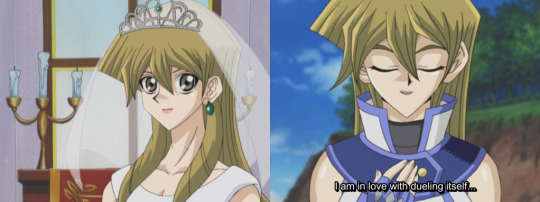
Judai and Asuka's first meeting isn't necessarily a romantic chemical wedding, because one happens in season 3 and it's with someone who's not Asuka - but it is still a union of opposites. Anima and Animus is something I plan to cover more in season 2 but basically Jung divides the psyche into two part, the feminine aspects of personality and the masculine aspects and makes the observation that most men aren't accustomed to their feminine side and vice versa. Men must therefore come into touch with their feminine side and integrate their feminine traits into their everyday life in order to become fully realized people.
Judai is basically dueling with the female version of himself, another person who loves dueling above everything else and uses it as a way of conencting with other,s and Asuka even pulls a Judai-like move, she threatens to get Judai and Sho expelled to extort a duel out of Judai because she wanted to size him up as a potential dueling rival.
Asuka also plays the role of the high priestess in the fool's journey, to Yugi's magician. As it's through his encounter with Asuka that Judai gains passive guidance for what his role will be in season 1 - as she's the one actively looking for her brother Fubuki which will lead Judai to the seven stars plotline. In fact, while Judai came to the anbadoned dorm because him and Sho were sharing scary stories, he sticks around and explores it deeper specifically because he heard Asuka make a mention that her brother went missing there.

This leads to the introduction of shadow duels - duels where characters bet their souls on the line and the consequence for losing is being consumed by darkness, otherwords a failure in alchemy.
The entirety of season one is basically one long pattern of Judai who only duels for fun and to connect to other people learning that there are darker sides to dueling (shadow games) and going through one long process of realizing that not everything is for fun and there are times you duel with your life on the line. Or at least, that's what he should be doing but a lot of Judai's development is stalled until season 3. However, that stage is still set up here.
Judai does not really grow a lot in season one, but we have other characters going through their own mini-alchemeical journeys in order to reflect Judai. For instance, each season Judai has a rival / foil that contests with him for the hero role. In season 1 it's Manjoume who thinks he's the one more set up to inherit the next king of games.
Manjoume goes through a pretty common arc for shonen characters. He's suddenly defeated by the appearance of a new rival, he loses all confidence in himself, he goes off somewhere else to train and then returns to defeat the rival that knocked him off his pedestal.
However, that usually happens to protagonists. Manjoume, a rival character, goes through more of a journey than the main character of his own show at least in season 1. Manjoume follows the nigredo formula pretty much to a T.
We see Manjoume break down completely. He loses to Judai even after getting cards from Crowler (his Dragon card is even killed by Judai) he then has a mental breakdown and tries to cheat against Misawa only to lose again and leave the school entirely. Even his deck goes through the process of dissolve and coagulate, as he has to get rid of his old deck and then find 40 new cards in the northern tundra and put together a new deck from scratch. He even returns to Duel Academy wearing black and purple after having gone through the process of breaking down entirely and reforming to signify his change in the nigredo stage.
This is the kind of arc and internal struggles you give your main character so we find their growth and journey compelling, but Judai's basically already a dueling prodigy he doesn't need to become stronger as a duelist. In fact Manojoume's internal insecurities are more at focus in this arc than the main character's too.

Judai is usually the character who duels the main boss, but in season 1 and 2 he rarely if ever feels the pressure to win the same way that Manjoume does in just this one duel with relatively little stakes. In fact if alchemy especially nigredo requires boiling and pressure in order to change the chemical composition of the metal that they're currently boiling, Manjoume is more emblematic of that chemical change -> heat and pressure allowing him to metamorphosize into a new person.

In fact Judai purposefully doesn't talk to Manjoume during this scene because he doesn't feel like there's anything he could say on an emotional level that would help him b/c Judai isn't really mature enough to understand that feeling of responsibility and pressure Manjoume is struggling under - he just tries to work it out in a duel instead.
Season 1 is all about Nigredo, about plunging into darkness but Manjoume who plunges into darkness to find himself and to an extent Asuka who journeys into the darkness to find her brother are the oens who actually experience a change while Judai remains a mostly static character. He is the impetus of change for both of these characters, but he doesn't really change himself just yet.
So Asuka has an exernal objective -> find Fubuki, and Manjoume has an internal flaw -> His insecurity and inferiority complex and both of them need to plunge into darkness in order to remedy these things. Judai doesn't have any objective at all, but because he comes into contact with Asuka and Manjoume he helps Asuka with her quest and Manjoume with his internal insecurity.
From early on Judai despite literaly fighting with a deck called the "Elemental Heroes" is more of a designated hero, then an actual hero. As I pointed out above other characters struggle with the kind of insecurities that protagonists usually struggle with. Judai doesn't need to learn to believe in himself or be a better duelist, he's already a dueling prodigy, that's Sho, and Manjoume's struggles. Asuka is the one who has a personal motivation to save someone because she wants to save her brother, Judai only helps because he wants to help Asuka. Judai is picked to fight once the seven stars start appearing not because he is the most heroic character, but because he is the best duelist.
It's not that Judai doesn't help when someone asks him for a helping hand. He always gives his help when asked for it, but otherwise he's an incredibly passive character who continually "only duels for fun" even when the stakes get higher. He only feels the pressure to win that Manjoume did for one episode after the gauntlet of Darkness Camula and even then it's immediately resolved with a duel against Kaibaman.
However, despite not having the things usual main character have, an outward objective, or an obvious internal flaw that he needs to fix or boil away in the alchemy sense he's still the central character of the show. Fubuki is Asuka's brother, and yet when he appears again it's Judai who duels him.
Yami no Game - Versus Darkness
The first instance of actual plot in this show happens in episode 29 (Yu Gi Oh is a well paced show / sarcasm) when Fubuki / Darkness appears as a member of the seven stars, to challenge Judai for his key, kidnapping his friends and holding them hostage in a volcano for an ante. This entire duel is steeped with alchemy symbolism and is to be honest one of my favorite in the series. It's also Judai's first real "yami no game" if one counts the duel at the dorm and the duel against Jinzo as warmups.
To recap from above, Nigredo is the first step of alchemy, it's usually associated with fire, the color black, and the death of a dragon. This duel takes place in a volcano. A volcano where dragons made of flame rise up from the lava, and Judai's opponent Darkness walks right out of the fire to face him.
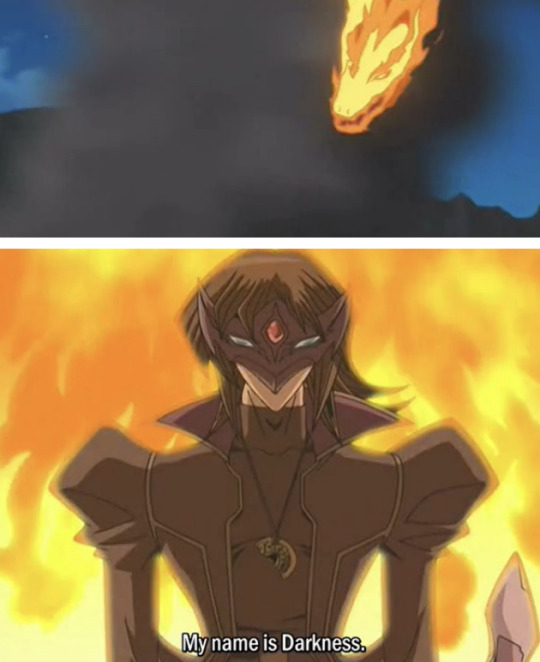
Darkness not only hits all the symbols for the first stage of alchemy, his deck also corresponds to this stage. He's running a red eyes black dragon deck, a deck who's ace monster "Red-Eyes Darkness Dragon" gets stronger for every single monster in your graveyard. If Nigredo is initiated by the death of a dragon. They fight on what is basically a graveyard of dragons with dragon spirits constantly jumping out of the lava, the dead spirits empowering Red Eyes Darkness Dragon even further.
Red Eyes Darkness Dragon - Cannot be Normal Summoned/Set. Must be Special Summoned (from your hand) by Tributing 1 "Red-Eyes Black Dragon". Gains 300 ATK for each Dragon monster in your GY.
Fubuki arrives in practically a storm of fire, promising to melt everything away if Judai doesn't take things seriously. He even calls Judai half-hearted for not realizing what is at stake here. Once again he's applying heat and pressure to try to force a transformation inside of Judai.
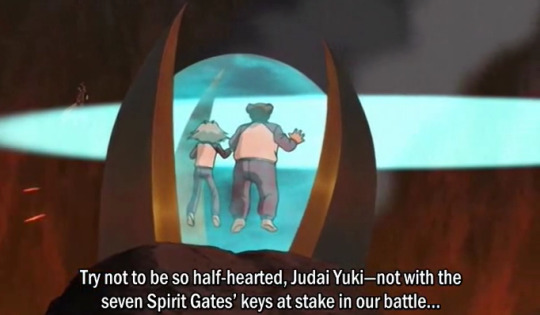
It is the first and last time for awhile someone challenges Judai seriously on this level (as most of the seven star matches bar Camula get kind of silly after this) but it also incorporates the Nigredo and the Work of Self, 'if you cannot overcome the blackness and despair of your own self, you will be burned away'. The volcano, the dragon graveyard, red eyes darkness dragon all incorporate the image of the skull, the dragon and the fire which reduces one to black matter.
In a normal narrative this is where Judai would succumb to the pressure like Manjoume did and start to take things seriously, but once again Yu Gi Oh Gx is building up a three season long-con. The one who changes isn't Judai, but rather Fubuki who's internal darkness is purified by the end and we see him return to his usual self, though he'll call upon the darkness again in season 2 and then season 4 because purification isn't' a one and done process.
We're shown other characters around Judai changing, and Judai often being the impetus for that change, but we're not shown exactly why until all the way in episode 45 when Amnael decides to play his hand, because Yu-Gi-Oh Gx is a well paced show (sarcasm).
If we focus on the duels that develop Judai as a character it goes a little something like:
1st duel against crowler establishes his use of fusion
1st duel against asuka - chemical wedding / anima + animus
1st duel against zane - establishes relationship with sho
3 duels against Manjoume - Manjoume's arc
Judai vs Misawa - More for Misawa's arc because it teaches him that isntinct can win against obsessive thinking over strategy.
Judai's 3 shadow duels (vs Titan, vs. Jinzo, vs. the Gravekeepers)
Finally, vs. Darkness / Fubuki
The only duels that really are about Judai as a character are Yami no Games, the ones where Judai is forced to bet his life on the line in a duel because those are the duels that challenge his philosophy that dueling is just for fun and his desire to duel purely for his own entertainment. Basically every other duel that Judai gets into up until this point is for other characters not him, only the Yami no Games int true Nigredo fashion push Judai's arc along as he slowly realizes there are times where he needs to carry responsibility and weight on his shoulders and keep going.
When the pressure of dueling becomes too much for him after Darkness and Camula he does receive an alchemcial bath, in the form of a hotsprings episode where he gets to fight Kaibaman in a low stakes duel which relieves him of the pressure temporarily. Kaibaman is also dressed in white, and plays the blue eyes white dargon the counterpart to the red eyes black dragon.
The impetus for this episode is a dream where Judai sees himself losing against an unknown shadowy dragon, which causes both of his friends to burn away in fire while he's consumed by the darkness as a price for losing the yami no game.

In those last minutes too Judai's more concerned with his friends who are crying out for his help then he is for the fact that he himself is being consumed by the darkness. Something which will come back in season 3, because Seasons 1 and 2 are excellent at setup and foreshadowing if nothing else.
Foreshadowing because there is a scene where Judai's friends do burn away and he does sink into darkness, his nigrido and all his anxieties reflected in this dream here prove true but once again it happens in season 3.
Things that seem like they are neatly resolved in seasons 1 and 2 will always be called back to in Season 3. Judai goes through several mini arcs of "I need to take dueling more seriously" only to revert back to his usual carefree irresponsible attitude, because in seasons 1 and 2 the consequences for Judai not taking thing seriously and messing up aren't as severe as they'll eventually be.
Judai is called to in his Yami no Games plunge the depths of his own personal darkness, Daitokuji leads him to three shadow games to make him realize there are games where real life people can get hurt - Fubuki yells at the top of his lungs not to half-ass this duel or his friends will burn away into nothing. Judai is called to explore those depths of darkness... he just doesn't. Manjoume does, Fubuki does, Asuka does, even Sho and Ryo have an honest conversation about their relationship as brothers when Camula holds Sho hostage so Ryo will lose the duel.
I'd argue there are hints that Judai does have an inner darkness that he's refusing to examine all the way back in season 1 too, because the foreshadowing in this show is excellent. In episode 5 when they're all sharing ghost stories, Judai shares a story about how he thought he could hear the voices of his duel monsters when he was asleep.

Only for Judai to jokingly end the horror story by declaring that he didn't see a thing.

Those who have watched season 3 know that this is a bald-faced lie, because it was right around that age that Judai was given a haunted card by his father that put all of his friends into comas and made it so no one wanted to duel with him let alone be around him. Judai used to be able to see card spirits, until the traumatic incident of one dark card spirit made him cut off his ability to see them entirely. Judai tells Sho half the story, and then blows the rest off as a joke.
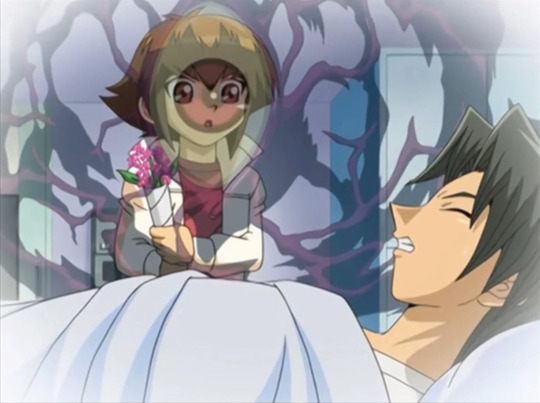
This scene is pretty clear season 3 foreshadowing, but also in a sense of alchemy, Judai is failing to confront the darkness here because he remains ignorant of his repressed childhood memory. He muses for a second on the fact that he can remember hearing card spirits when he was younger, but doesn't reflect on why he stopped hearing them because he's coping poorly with that traumatic childhood incident still. Which is why he is so stagnant because even when he's given opportunities too - he doesn't reflect on his past, or even reflect on who he is whatsoever.
This small detail of his backstory doesn't come until season 3 so technically I'm spoiling you, we're given no information at all in season 1 why Judai loves dueling so much and why it seems to be the only thing he cares about not because the writing is bad but because Judai himself never reflects on those things.
As Judai plunged into the world of Yami no Games, he could have reflected more seriously on these things, but he didn't because Judai is also more concerned with other people, and forced to duel to save other people first before himself.
Judai fails to commit nigredo, and this normally would result in reverse alchemy or even character stagnation but that doesn't happen until season 3 - mainly because in season 1 Judai has a mentor to sweep in and kind of fix his mistakes for him.
There's a whole bunch of duels in between this, but really Judai's next plot relevant duel is episode 44 the Seventh Shadow. When Daitokuji goes missing the gang goes out searching for him, only to find that he's facing Daitokuji as the alchemist Amnael and the sevenths star.
There's a billion alchemy references in this duel, because as I said Judai has only three really plot important alchemy duels this season the first being darkness, the second amnael, and the third Kagemaru and so all the symbolism is frontloaded into this one.
First off, Daitokuji carries around an emerald tablet for a millenium item gifted to him by Kagemaru and he also uses this symbol - which resembles the alchemy symbol for the sun, but also a traditional depiction of an ouroboros a snake eating itself.


The ouroboros a symbol that appeared in alcehmy in Graeco-roman egypt, the same era that the Amneal Story appears from. A symbol which ties to the sun, mercurius (hermes) and his caducous staff which contained a male and female snake interlaced.
In Egypt the sun went on a journey to the underworld every night, only to come back to the world of the living every morning. In the duel itself, Daitokuji is long dead, and Judai must in a way kill his mentor as apprentice in order to replace him as alchemist. Daitokuji also comes right back immediately as a ghost, because life and death are an eternal cycle like the ouroboros itself.
Daitokuji goes by the name of Amnael an angel who appeared before Isis to reveal the great mystery to her. Amnael becomes a lover to Isis and reveals the secret to her, but first makes her swear a mighty oath by "fire and water, like and darkness, by fire, water, air, and earth" and a variety of Greek and Egyptian Deities.
The great secret in question:
“So go then, my child, to a certain laborer named Achaab, and ask him what he has sown and what he has harvested, and you will learn from him that the man who sows wheat also harvests wheat, and the man who sows barley also harvests barley. For a nature rejoices another nature, and a nature conquers another nature.”
In other words the great secret of alchemy is that you reap what you sew. In other words alchemy, like chemical reactions is all about actions and consequences.
This also ties to the phrase "as above, so below" which is chanted constantly in the two episode duel against Daitokuji. A phrase which is on the emerald tablet, (borrowing this from Kate). The emerald tablet is also wielded by hermes, so once again, greco-roman / egyptian alchemy lore.
"That which is above is like to that which is below, and that which is below is like to that which is above."
Things in the macrocrosm are mirrored in the microcosm, or in other words BE THE CHANGE YOU WANT TO BE IN THE WORLD. You have to change yourself before you can change others. The personal change that an alchemist goes through in acquiring the philosopher's stone and finishing a chemical wedding will radiate out to the rest of the world.
This is the role that the master alchemist gives to his apprentice.
Amnael and Judai's duel is basically a crash course of alchemy for dummies. Amnael's card archetype the Alchemy Beasts uses a distillation to summon seven different alchemy beasts which resembles the seven step process of alchemy.
Aretos the time
Ekanos the Mercury
Leon the Lead
Moonface the Silver
Ouoroboros the Bronze
Salamandra the Steel
Golden Homonculus
Coincidentally the number seven shows up a lot this season. The seven stars are the duelists that the main characters have to face in yami no games, probably a reference to the fact that there are seven heavenly bodies in the ancient medieval world, saturn, jupite,r mars, venus, mercury, moon, and sun which also correspond with the seven steps of refining metal into gold listed above. Sun being gold, and again sun being associated with Judai.
While also using support spell cards that reference the nigrido, albedo and rubedo. Before finally using the Macro-cosmos card... which is again covered above changes on the microscale effect the macroscale.
All in the world originates from a single substance altered in various ways to form heaven and earth. Even the world of man known as the microcosmos and the world of the heavens known as the macrocosmos.
So, humans and outerspace are connected?
Amnael then procees to push the sun through three phases, helios - the primordial sun, Helios - Duo Megistus, and Helios - tris magestius. The second stage being a reference to this.

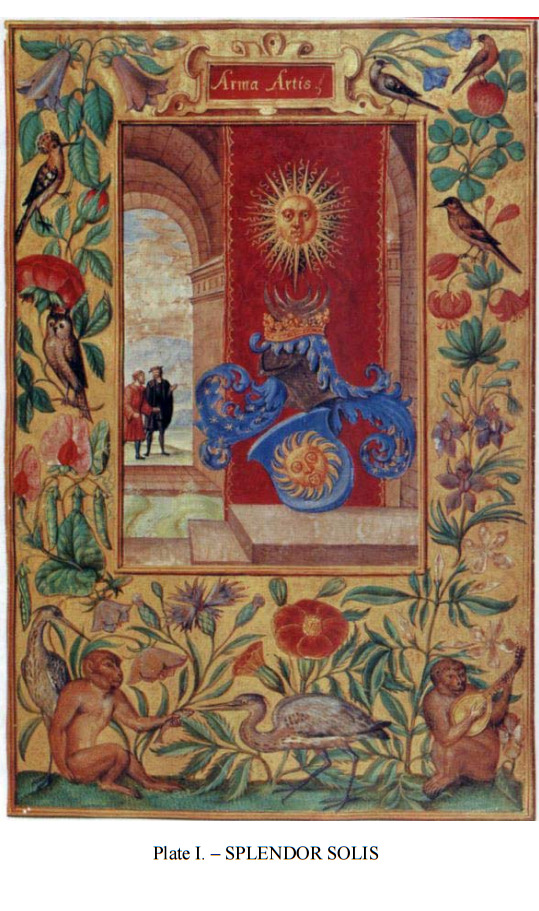
Outside the building where this standard is housed are two men. Their body postures might suggest they are teacher and initiate. The master points to the standard, separated from them by swirling and overflowing waters. There is also a three-step platform leading up to the standard, possibly reflective of the tria prima which all alchemical substances are made from; Paracelsus defined these as Mercury (Spirit), Salt (Body), and Sulfur (Soul)
The master is teaching the student - there are two men, two suns, ad even two babboons in this piece. Sharing and art. Giving and taking. The teacher shares, and the student takes, indicative of the fact this is Daitokuji's final lesson.
In alchemy three suns also appear to show the three stages of aclehmy, the blakckun, white, sun and red sun. The black sun is considered important for the dissolution stage of alchemy. The man holding the flask contianing the golden liquid, made from the four elementsor rather Plate 2 is also referenced in this duel.


Daitokuji is the old man with the flask, the duel also concludes with an elixir created from the four elements of nature. Judai creates elemetal hero elixir by fusing four elemental heroes of different elements in his graveyard. After her reflects upon what he's gained in the past year at Duel Acamdey compared to what he didn't have before - friends.
At which finally Daitokuji elucidates why he chose Judai of all people as his chosen pupil.
"Alchemy 's ability to change all into gold is merely a superficial phenomenon. It's true aim is to change the hearts of people into purer, nobler things."
Judai as we'll find out in season 3 started out the story as a friendless loser, and his desire to connect to others through dueling, causes him to purify the people around him by enduring many trials and tribulations for their sakes.
Amnael is also the first to notice the potential of Judai, and that this potential lies within Judai's darkness. Though, even though Judai is pushed to do a little self reflection in this duel (admitting to himself that he was lonely before he came to duel academy and this is the first time in his life he's had friends) he doesn't actually look inside that darkness towards those repressed childhood memories we were looking at earlier.
If anything while Daitokuji's lesson is a short-term fix, like a bandage over Judai, it doesn't actually help him in the long-run. This is because the reason why Judai is succesful in this season is not really anything of Judai's doing, but because Daitokuji the master rigs it for him. Daitokuji is the one who prepares challenges to increase Judai's strength at dueling, Daitokuji is the one who hands Judai the emerald tablet that lets him make a philosopher's stone during his duel with Kagemaru, Daitokuji is the architect of most of the plot in season 1 and Judai just kind of passively follow his script. Judai is not the alchemist in the first season, he's the apprentice and basically he only makes his first step in his journey by consuming his master and that's in episode 45, when the season is 4/5ths of the way over.
Judai is the alchemist, he's supposed to change others by forming relationships with them the same way that he can fuse two monsters together to form a stronger monster. However, he also has to change himself in order for that to happen and Judai doesn't change through seasons 1 and 2 - he gets by in the short term but it costs him long term development.
Because the duels Judai gets into are always about other people and not about himself. Even the climactic duel of the season against Kagemaru, Judai barely knows who this guy is. Judai's not there by choice, Judai is there because Daitokuji set things up so that his student Judai would defeat Kagemaru the main villain.
Judai's not dueling for himself so we barely learn anything from these duels, and Judai still doesn't really take this duel seriously. The one small thing we get from him is this:

"I feel sorry for you, you can control all the powerful monsters you want, but if you're the one wiping out duel monsters... no one is going to see you as a friend. And that'd make you lonely right? Live as long as you want, but without friends around, it'd just be boring right?"
Which sounds like a pretty shallow statement, but is telling of Judai. Judai had no friends before coming to Duel Academy. Judai gained friends because he was a strong duelist, Sho looks up to him because he's a dueling prodigy like Ryo, Asuka befriended him as a duel rival first, Manjoume only views him as a rival, Ryo sees Judai as someone who's potential for growth surpasses him because Ryo being a perfectionist feels like his perfectionism is stagnant. Judai's only way to connect with people is through duel monsters, and the reason most of these people have an interest in him is because he's a dueling prodigy. Thus, Judai equates dueling with making friends, and believes he has to keep getting into duels like this for the sake of his friends rather than himself.
Judai only wants to duel for fun, but is put into situations where he has to duel with high stakes, because everyone relies on him as the best duelist around, and because he thinks the only reason he made friends in the first place is his skill as a duelist.
Thus, Judai even when forced into these stressful duels, will fall back on his whole "I'm just trying to have fun" thing in order to cope because he's not really here because he wants to but because other people have put him into this situation. Therefore, he doubles down on his own personal enjoyment to convince himself he's here because he wants to and so the pressure doesn't get to him the way he's seen it get to other people like Manjoume.
Judai goes through several trials that seem like Nigredo in season 1. He goes through yami no duels where his life are on the line, challenging his philosophy of only dueling thrilling opponents for fun. He's put through literal trial by fire twice, first by Darkness, then by Daitokuji, situations where he will literally burn away into ash if he doesn't perform. He even duels a Yami no Game with Kagemaru where he forges a philoopsher's stone to create 3 custom cards to win the duel - but once again that's not really Judai who forged it because Daitokuji did it for him.
Daitokuji argues that the true alchemy changes the hearts of other people into nobler, purer things which Judai has arguably done for his friends - but what about his own heart?
Other people around Judai change, and are changed by Judai, but Judai himself for the first two seasons does not change. Even in incredibly plot important duels, and I'm including season 2 as well, because in both cases Kagemaru and Saio Judai wasn't really facing himslf or even a reflection of himself. Kagemaru is Daitokuji's enemy and mess to clean up he passed onto Judai, and Saio is Edo's chilhood best friend who became a victim to the light of destruciton. In both cases Judai swept in to fix things because that's what Judai does, he fights others battles for them because he himself lacks either an internal or external reason to duel - and he doubts his abiltiy to make friends if he didn't go around fixing everyone's problems.
As Above, So Below
It is other characters who go through a Nigrido phase in Season 1. However - their Nigrido phases will be reflected in Season 3. These characters experiencing their own inner turmoils mirror the obstacles that Judai has to face ahead of him.
Asuka
Season 1: Judai helps Asuka searching for her brother who's disappeared into the darkness.
vs.
Season 3: Judai travels into another dimmension to find Johan after he disappears from this world, only to find he's possessed the same way Fubuki is. Judai also blames himself for Johan's disappearance and takes on the burden to save him entrely by himself, like how Asuka leads the search for her brother.

Manjoume
Season 1: Manjoume is completely crushed by his responsibility to always win that his brother's force onto his shoulders.
vs.
Season 3: Judai being told to his face he wont' be able to win because he doesn't carry any burdens or serious responsibilities, because that's what drives people to try hard when they're pushed into a corner. Only for Johan to tell Judai that much like Manjoume is being pressured by both of his brothers, Judai has always had to carry everyone's hopes on his shoulders. When he cant carry them anymore, he has a breakdown that pretty much mirrors Manjoume's season one breakdown word for word.
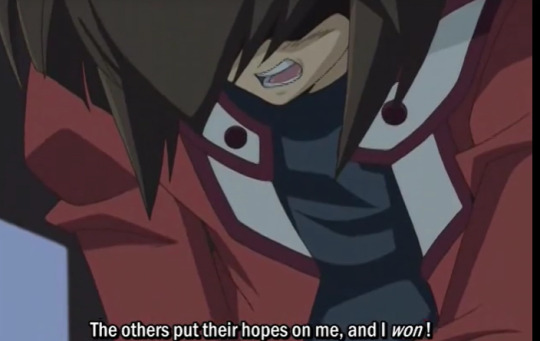
But, even then I won. The others hope their hopes on me, and I won! But still...!! They're all gone. There really was something missing within me. But what is it? What was missing?
Sho
In season one: Judai basically becomes the replacement for Sho's brother, who he has a poor relationship with and Sho has to face his inferiority complex towards his brother head on.
vs.
In season three: Shoe becomes the trigger for Judai's growth when he rejects Judai entirely and stops calling him "aniki" being the last one to abandon him in the dark world when just about everything goes wrong.

But, I guess I thought wrong. Big bro you've just been dueling to satisfiy yourself. You're not my big bro (aniki). You're not my big bro (aniki).
Fubuki
Judai even becomes lost and faces his inner darkness like Fubuki does, the first person to appear before Judai and challenge him to a Yami no Game. Fubuki who was possessed by a dark version of himself who valued power above everything else and then got lost in that darkness.
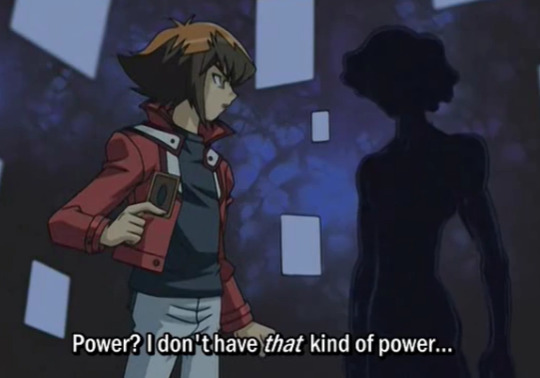
Judai has no arc in season one, and instead helps other characters along in their arcs. However, Judai's inability to change himself or confront his own inner darkness bites him when two seasons later.
Judai's arc then reflects aspects of all of their arcs. Sho's afraid that his brother doesn't love or respect him because he's an inferior duelist to Ryo. Judai loses Sho's love and respect. Asuka has to go on a journey into a darkness to find her loved one and fears Fubuki may never return. Judai repeats that same journey for Johan. Manjoume's cracks under the pressure his brothers put onto him to always win because his family's love is very conditional. Judai finally cracks when he realizes a lot of his friendship was built on the very conditional fact that he had to always win duels for them and fight for other people's hopes and dreams and not his own. In season one Judai cleanses Fubuki's inner darkness, in season 3 Judai sinks into his own inner darkness that's been there and ignored all along, and so on.
The nigredo phase is about cleansing your own impurities, and Judai is presented to us like a pure shonen hero who doesn't need to be cleansed so he spends his entire time cleansing other people - only for it to turn out his heart turned out to be darker and more selfish than anyone expected.
#ygo gx#yu gi oh gx#yu gi oh#judai yuki#alchemy#this took all day#and i still have like another one to write#ygx meta#ygo meta
42 notes
·
View notes